High quality images from the Hubble telescope. High-resolution images of the Moon and UFOs from the Hubble telescope
Today, on Cosmonautics Day, we will enjoy images from the Hubble orbital telescope, which has been in orbit of our planet for more than twenty years and continues to reveal to us the secrets of space to this day.
NGC 5194
Known as NGC 5194, this large galaxy with a well-developed spiral structure may have been the first spiral nebula discovered. It is clearly visible that its spiral arms and dust lanes pass in front of its satellite galaxy - NGC 5195 (left). The pair are located about 31 million light years away and officially belong to the small constellation Canes Venatici.
Spiral galaxy M33- a medium-sized galaxy from the Local Group. M33 is also called the Triangulum galaxy after the constellation in which it is located. About 4 times smaller (in radius) than our Milky Way Galaxy and the Andromeda Galaxy (M31), M33 is much larger than many dwarf galaxies. Because M33 is close to M31, some think it is a satellite of this more massive galaxy. M33 nearby Milky Way, its angular dimensions are more than twice the size of the full Moon, i.e. it is perfectly visible with good binoculars.
Stefan Quintet
The group of galaxies is Stefan's Quintet. However, only four galaxies in the group, located three hundred million light years away, participate in the cosmic dance, moving closer and further away from each other. It's quite easy to find extra ones. The four interacting galaxies - NGC 7319, NGC 7318A, NGC 7318B and NGC 7317 - have yellowish colors and curved loops and tails, the shape of which is caused by the influence of destructive tidal gravitational forces. The bluish galaxy NGC 7320, located in the image at the top left, is much closer than the others, only 40 million light years away.
Andromeda Galaxy- This is the closest giant galaxy to our Milky Way. Most likely, our Galaxy looks about the same as the Andromeda Galaxy. These two galaxies dominate the Local Group of galaxies. The hundreds of billions of stars that make up the Andromeda Galaxy combine to produce a visible, diffuse glow. The individual stars in the image are actually stars in our Galaxy, located much closer to the distant object. The Andromeda Galaxy is often called M31 because it is the 31st object in Charles Messier's catalog of diffuse celestial objects.
Lagoon Nebula
The bright Lagoon Nebula contains many different astronomical objects. Particularly interesting objects include a bright open star cluster and several active star forming regions. When viewed visually, the light from the cluster is lost against the background of the overall red glow caused by hydrogen emission, while the dark filaments arise from the absorption of light by dense layers of dust.
The Cat's Eye Nebula (NGC 6543) is one of the most famous planetary nebulae in the sky. Its haunting, symmetrical shape is visible in the central portion of this dramatic false-color image, specially processed to reveal a huge but very faint halo of gaseous material, some three light-years in diameter, that surrounds the bright, familiar planetary nebula.
The small constellation Chameleon is located near the south pole of the World. The picture reveals the amazing features of the modest constellation, which reveals many dusty nebulae and colorful stars. Blue reflection nebulae are scattered across the field.
Cosmic dust clouds glowing faintly with reflected starlight. Far from familiar places on planet Earth, they lurk on the edge of the Cephei Halo molecular cloud complex, 1,200 light-years away. Nebula Sh2-136, located near the center of the field, is brighter than other ghostly apparitions. Its size is more than two light years, and it is visible even in infrared light
The dark, dusty Horsehead Nebula and the glowing Orion Nebula contrast in the sky. They are located at a distance of 1500 light years from us in the direction of the most recognizable celestial constellation. And in today's remarkable composite photograph, the nebulae occupy opposite corners. The familiar Horsehead Nebula is a small, dark cloud in the shape of a horse's head, silhouetted against a background of red glowing gas in the lower left corner of the picture.
Crab Nebula
This confusion remained after the star exploded. The Crab Nebula is the result of a supernova explosion observed in 1054 AD. The supernova remnant is filled with mysterious filaments. The filaments are not just complex to look at. The extent of the Crab Nebula is ten light years. At the very center of the nebula is a pulsar - neutron star with a mass equal to the mass of the Sun, which fits into an area the size of a small town.
This is a mirage from a gravitational lens. The bright red galaxy (LRG) shown in this photograph has been distorted by its gravity to the light from a more distant blue galaxy. Most often, such a distortion of light leads to the appearance of two images of a distant galaxy, but in the case of a very precise superposition of the galaxy and the gravitational lens, the images merge into a horseshoe - an almost closed ring. This effect was predicted by Albert Einstein 70 years ago.
Star V838 Mon
For unknown reasons, in January 2002, the outer shell of the star V838 Mon suddenly expanded, making it the brightest star in the entire Milky Way. Then she became weak again, also suddenly. Astronomers have never seen a stellar flare like this before.
Birth of planets
How are planets formed? To try to find out, the Hubble Space Telescope was tasked with taking a closer look at one of the most interesting of all nebulae in the sky - the Great Orion Nebula. The Orion Nebula can be seen with the naked eye near the belt of the constellation Orion. The insets in this photo show numerous proplyds, many of them stellar nurseries that likely house forming planetary systems.
Star cluster R136
At the center of the star-forming region 30 Doradus lies a gigantic cluster of the largest, hottest, and most massive stars known to us. These stars form the R136 cluster, captured in this image taken in visible light by the upgraded Hubble Space Telescope.
Brilliant NGC 253 is one of the brightest spiral galaxies we see, yet one of the dustiest. Some call it the "Silver Dollar Galaxy" because it is shaped like that in a small telescope. Others simply call it the "Sculptor Galaxy" because it lies within the southern constellation Sculptor. This dusty galaxy is 10 million light years away
Galaxy M83
Galaxy M83 is one of the closest spiral galaxies to us. From the distance that separates us from her, equal to 15 million light years, she looks completely ordinary. However, if we take a closer look at the center of M83 using the largest telescopes, the region appears to be a turbulent and noisy place.
Ring Nebula
She really looks like a ring in the sky. Therefore, hundreds of years ago, astronomers named this nebula according to its unusual shape. The Ring Nebula is also designated M57 and NGC 6720. The Ring Nebula belongs to the class of planetary nebulae; these are gas clouds that emit stars similar to the Sun at the end of their lives. Its size exceeds the diameter. This is one of Hubble's early images.
Column and jets in the Carina Nebula
This cosmic column of gas and dust is two light years wide. The structure is located in one of the largest star-forming regions of our Galaxy, the Carina Nebula, which is visible in the southern sky and is 7,500 light-years away.
Center of the Omega Centauri globular cluster
At the center of the globular cluster Omega Centauri, the stars are packed ten thousand times more densely than the stars in the vicinity of the Sun. The image shows many faint yellow-white stars smaller than our Sun, several orange red giants, and the occasional blue star. If two stars suddenly collide, they can form one more massive star, or they can form a new binary system.
A giant cluster distorts and splits the image of the galaxy
Many of them are images of a single unusual, beady, blue ring-shaped galaxy that happens to be located behind a giant cluster of galaxies. According to latest research, in total, at least 330 images of individual distant galaxies can be found in the picture. This stunning photograph of the galaxy cluster CL0024+1654 was taken by the NASA Space Telescope. Hubble in November 2004.
Trifid Nebula
The beautiful multi-colored Trifid Nebula allows you to explore cosmic contrasts. Also known as M20, it lies about 5,000 light-years away in the nebula-rich constellation Sagittarius. The size of the nebula is about 40 light years.
Centaurus A
A fantastic array of young blue star clusters, giant glowing gas clouds and dark dust lanes surround the central region of the active galaxy Centaurus A. Centaurus A is close to Earth, 10 million light years away.
Butterfly Nebula
Bright clusters and nebulae in Earth's night sky are often named after flowers or insects, and NGC 6302 is no exception. The central star of this planetary nebula is exceptionally hot: its surface temperature is about 250 thousand degrees Celsius.
An image of a supernova that exploded in 1994 on the outskirts of a spiral galaxy.
This remarkable cosmic portrait shows two colliding galaxies with merging spiral arms. Above and to the left of the large spiral galaxy pair NGC 6050 can be seen a third galaxy that is also likely involved in the interaction. All of these galaxies are located about 450 million light-years away in the Hercules cluster of galaxies. At this distance, the image covers an area of more than 150 thousand light years. And although this appearance seems quite unusual, scientists now know that collisions and subsequent mergers of galaxies are not uncommon.
Spiral galaxy NGC 3521 lies just 35 million light-years away in the direction of the constellation Leo. The galaxy, which extends over 50,000 light-years, has features such as jagged, irregular spiral arms festooned with dust, pinkish star-forming regions and clusters of young bluish stars.
Although this unusual emission was first noticed in the early twentieth century, its origin is still the subject of debate. The image shown above, taken in 1998 by the Hubble Space Telescope, clearly shows details of the jet's structure. The most popular hypothesis suggests that the source of the ejection was heated gas orbiting a massive black hole at the center of the galaxy.
Galaxy Sombrero
Galaxy M104's appearance resembles a hat, which is why it is called the Sombrero Galaxy. The image shows distinct dark lanes of dust and a bright halo of stars and globular clusters. The reasons why the Sombrero Galaxy looks like a hat are the unusually large central stellar bulge and the dense dark lanes of dust located in the galaxy's disk, which we see almost edge-on.
M17: close-up view
Formed by stellar winds and radiation, these fantastic wave-like formations are found in the M17 (Omega Nebula) nebula and are part of a star-forming region. The Omega Nebula is located in the nebula-rich constellation Sagittarius and is 5,500 light-years away. The patchy clumps of dense, cold gas and dust are illuminated by radiation from the stars in the image at top right and could become sites of star formation in the future.
What does the IRAS 05437+2502 nebula illuminate? There is no exact answer yet. Particularly puzzling is the bright, inverted V-shaped arc that outlines the top edge of the mountain-like clouds of interstellar dust near the center of the image. Overall, this ghost-like nebula includes a small star-forming region filled with dark dust. It was first spotted in infrared images taken by the IRAS satellite in 1983. Shown here is a remarkable, recently released image from the Hubble Space Telescope. Although it shows many new details, the cause of the bright, clear arc could not be determined.
Sun, 27/05/2012 - 17:41
The Hubble Space Telescope is an automatic observatory in orbit around the Earth, named after Edwin Hubble. The Hubble Telescope is a joint project of NASA and the European Space Agency; it is one of NASA's Large Observatories. Placing a telescope in space makes it possible to record electromagnetic radiation in ranges in which the earth's atmosphere is opaque; primarily in the infrared range. Due to the absence of atmospheric influence, the resolution of the telescope is 7-10 times greater than that of a similar telescope located on Earth. We invite you to see now best pictures from this unique telescope over the past few years. In the photo: The Andromeda Galaxy is the closest giant galaxy to our Milky Way. Most likely, our Galaxy looks about the same as the Andromeda Galaxy. These two galaxies dominate the Local Group of galaxies.
The hundreds of billions of stars that make up the Andromeda Galaxy combine to produce a visible, diffuse glow. The individual stars in the image are actually stars in our Galaxy, located much closer to the distant object. The Andromeda Galaxy is often called M31 because it is the 31st object in Charles Messier's catalog of diffuse celestial objects.
At the center of the Doradus star-forming region is a gigantic cluster of the largest, hottest, and most massive stars known to us. These stars form the R136 cluster captured in this image.
NGC 253: Brilliant NGC 253 is one of the brightest spiral galaxies we see, yet one of the dustiest. Some call it the “Silver Dollar Galaxy” because it is shaped like that in a small telescope. Others simply call it the “Sculptor Galaxy” because it lies within the southern constellation Sculptor. This dusty galaxy is located 10 million light years away.
Galaxy M83 is one of the closest spiral galaxies to us. From the distance that separates us from her, equal to 15 million light years, she looks completely ordinary. However, if we take a closer look at the center of M83 using the largest telescopes, the region appears to be a turbulent and noisy place.
The group of galaxies is Stefan's Quintet. However, only four galaxies in the group, located three hundred million light years away, participate in the cosmic dance, moving closer and further away from each other. The four interacting galaxies - NGC 7319, NGC 7318A, NGC 7318B and NGC 7317 - have yellowish colors and curved loops and tails, the shape of which is caused by the influence of destructive tidal gravitational forces. The bluish galaxy NGC 7320, pictured above left, is much closer than the others, just 40 million light-years away.
A giant cluster of stars distorts and splits the image of the galaxy. Many of them are images of a single unusual, beady, blue ring-shaped galaxy that happens to be located behind a giant cluster of galaxies. According to recent research, in total, at least 330 images of individual distant galaxies can be found in the picture. This stunning photograph of the galaxy cluster CL0024+1654 was taken in November 2004.
Spiral galaxy NGC 3521 lies just 35 million light-years away in the direction of the constellation Leo. It has features such as jagged, irregular spiral arms adorned with dust, pinkish star-forming regions, and clusters of young bluish stars.
Spiral galaxy M33 is a medium-sized galaxy from the Local Group. M33 is also called the Triangulum galaxy after the constellation in which it is located. M33 is not far from the Milky Way, its angular dimensions are more than twice the size of the full Moon, i.e. it is perfectly visible with good binoculars.
Lagoon Nebula. The bright Lagoon Nebula contains many different astronomical objects. Particularly interesting objects include a bright open star cluster and several active star forming regions. When viewed visually, the light from the cluster is lost against the overall red glow caused by hydrogen emission, while the dark filaments arise from the absorption of light by dense layers of dust.
The Cat's Eye Nebula (NGC 6543) is one of the most famous planetary nebulae in the sky.
The small constellation Chameleon is located near the south pole of the World. The picture reveals the amazing features of the modest constellation, which reveals many dusty nebulae and colorful stars. Blue reflection nebulae are scattered across the field.
The dark, dusty Horsehead Nebula and the glowing Orion Nebula contrast in the sky. They are located 1,500 light years away in the direction of the most recognizable celestial constellation. The familiar Horsehead Nebula is a small dark cloud in the shape of a horse's head, silhouetted against a background of red glowing gas in the lower left corner of the picture.
Crab Nebula. This confusion remained after the star exploded. The Crab Nebula is the result of a supernova explosion observed in 1054 AD. At the very center of the nebula is a pulsar - a neutron star with a mass equal to the mass of the Sun, which fits into an area the size of a small town.
This is a mirage from a gravitational lens. The bright red galaxy (LRG) shown in this photograph has been distorted by its gravity to the light from a more distant blue galaxy. Most often, such a distortion of light leads to the appearance of two images of a distant galaxy, but in the case of a very precise superposition of the galaxy and the gravitational lens, the images merge into a horseshoe - an almost closed ring. This effect was predicted by Albert Einstein 70 years ago.
Star V838 Mon. For unknown reasons, in January 2002, the outer shell of the star V838 Mon suddenly expanded, making it the brightest star in the entire Milky Way. Then she became weak again, also suddenly. Astronomers have never observed such stellar flares before.
Ring Nebula. She really looks like a ring in the sky. Therefore, hundreds of years ago, astronomers named this nebula according to its unusual shape. The Ring Nebula is also designated M57 and NGC 6720.
Column and jets in the Carina Nebula. This cosmic column of gas and dust is two light years wide. The structure is located in one of the largest star-forming regions of our Galaxy. The Carina Nebula is visible in the southern sky and is 7,500 light-years away.
Trifid Nebula. The beautiful multi-colored Trifid Nebula allows you to explore cosmic contrasts. Also known as M20, it lies about 5,000 light-years away in the nebula-rich constellation Sagittarius. The size of the nebula is about 40 light years.
Known as NGC 5194, this large galaxy with a well-developed spiral structure may have been the first spiral nebula discovered. It is clearly visible that its spiral arms and dust lanes pass in front of its satellite galaxy, NGC 5195 (left). The pair are located about 31 million light years away and officially belong to the small constellation Canes Venatici.
Centaurus A. A fantastic pile of young blue star clusters, giant glowing gas clouds and dark dust lanes surround the central region of the active galaxy Centaurus A.
Butterfly Nebula. Bright clusters and nebulae in Earth's night sky are often named after flowers or insects, and NGC 6302 is no exception. The central star of this planetary nebula is exceptionally hot: its surface temperature is about 250 thousand degrees Celsius.
An image of a supernova that exploded in 1994 on the outskirts of a spiral galaxy.
Galaxy Sombrero. Galaxy M104's appearance resembles a hat, which is why it is called the Sombrero Galaxy. The image shows distinct dark lanes of dust and a bright halo of stars and globular clusters. The reasons why the Sombrero Galaxy looks like a hat are the unusually large central stellar bulge and the dense dark lanes of dust located in the galaxy's disk, which we see almost edge-on.
M17: close-up view. Formed by stellar winds and radiation, these fantastic wave-like formations are found in the M17 (Omega Nebula) nebula. The Omega Nebula is located in the nebula-rich constellation Sagittarius and is 5,500 light-years away. The patchy clumps of dense, cold gas and dust are illuminated by radiation from the stars in the image at top right and could become sites of star formation in the future.
What does the IRAS 05437+2502 nebula illuminate? There is no exact answer. Particularly puzzling is the bright, inverted V-shaped arc that outlines the top edge of the mountain-like clouds of interstellar dust near the center of the image.
We present to you a selection of images taken using the Hubble orbital telescope. It has been in orbit of our planet for more than twenty years and continues to reveal to us the secrets of space to this day.
(Total 30 photos)
Post Sponsor:

Known as NGC 5194, this large galaxy with a well-developed spiral structure may have been the first spiral nebula discovered. It is clearly visible that its spiral arms and dust lanes pass in front of its satellite galaxy, NGC 5195 (left). The pair are located about 31 million light years away and officially belong to the small constellation Canes Venatici.
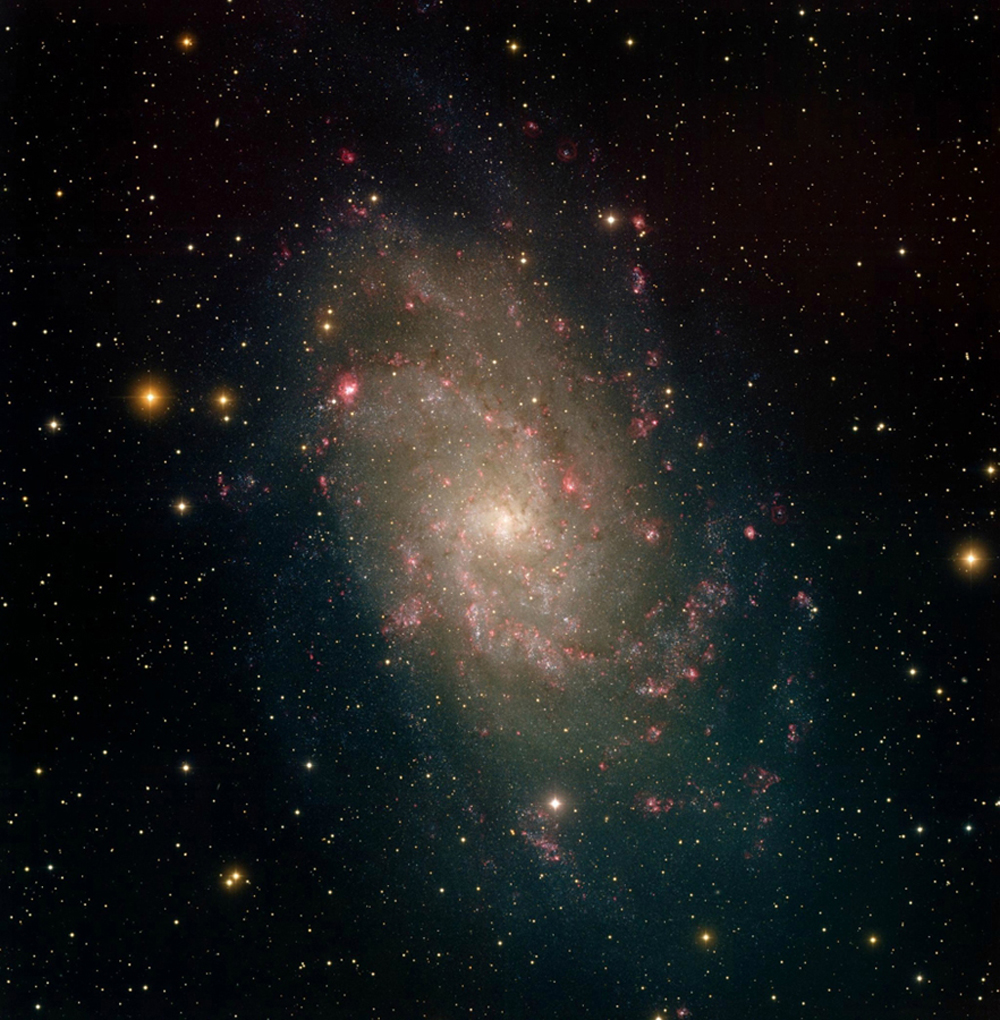
2. Spiral Galaxy M33
Spiral galaxy M33 is a medium-sized galaxy from the Local Group. M33 is also called the Triangulum galaxy after the constellation in which it is located. About 4 times smaller (in radius) than our Milky Way Galaxy and the Andromeda Galaxy (M31), M33 is much larger than many dwarf galaxies. Because M33 is close to M31, some think it is a satellite of this more massive galaxy. M33 is not far from the Milky Way, its angular dimensions are more than twice the size of the full Moon, i.e. it is perfectly visible with good binoculars.
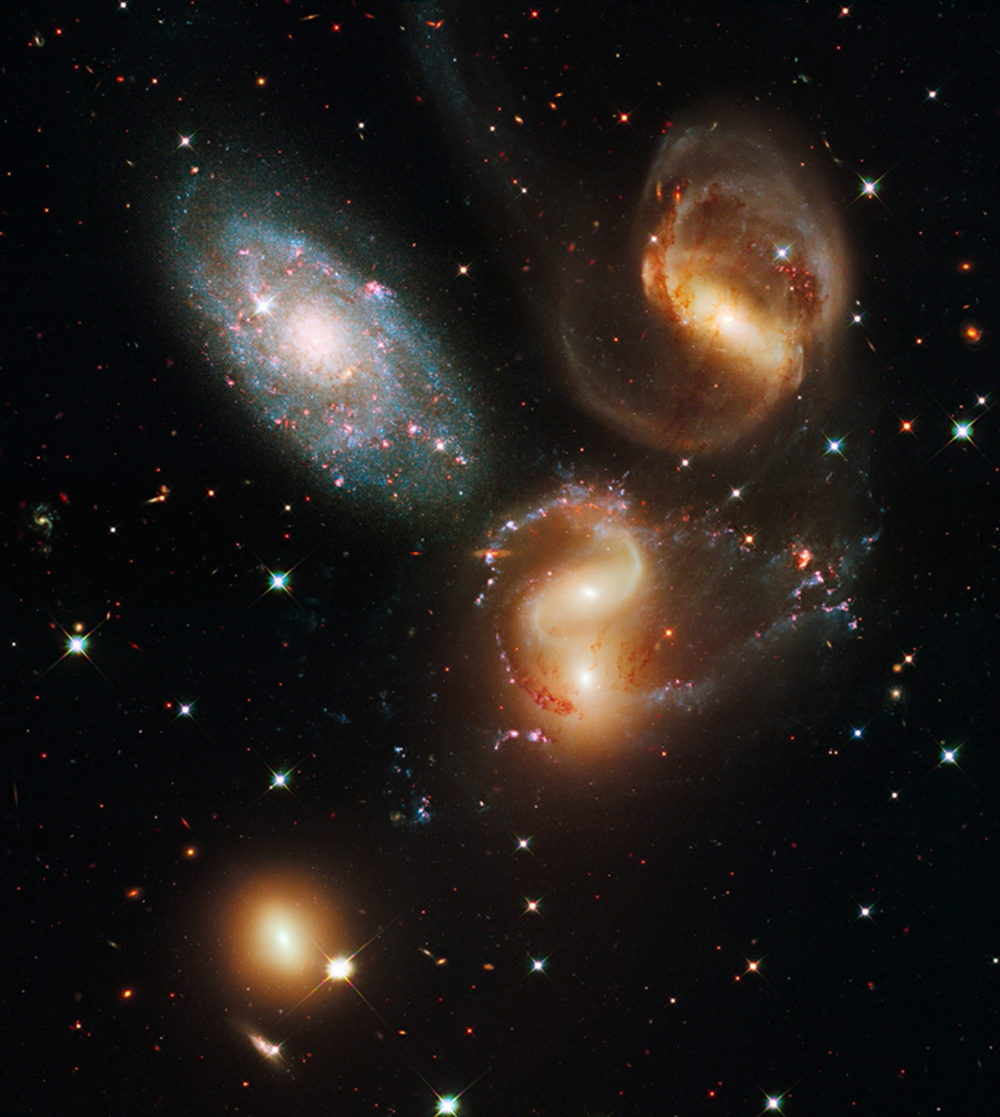
3. Stefan Quintet
The group of galaxies is Stefan's Quintet. However, only four galaxies in the group, located three hundred million light years away, participate in the cosmic dance, moving closer and further away from each other. It's quite easy to find extra ones. The four interacting galaxies - NGC 7319, NGC 7318A, NGC 7318B and NGC 7317 - have yellowish colors and curved loops and tails, the shape of which is caused by the influence of destructive tidal gravitational forces. The bluish galaxy NGC 7320, pictured above left, is much closer than the others, just 40 million light-years away.
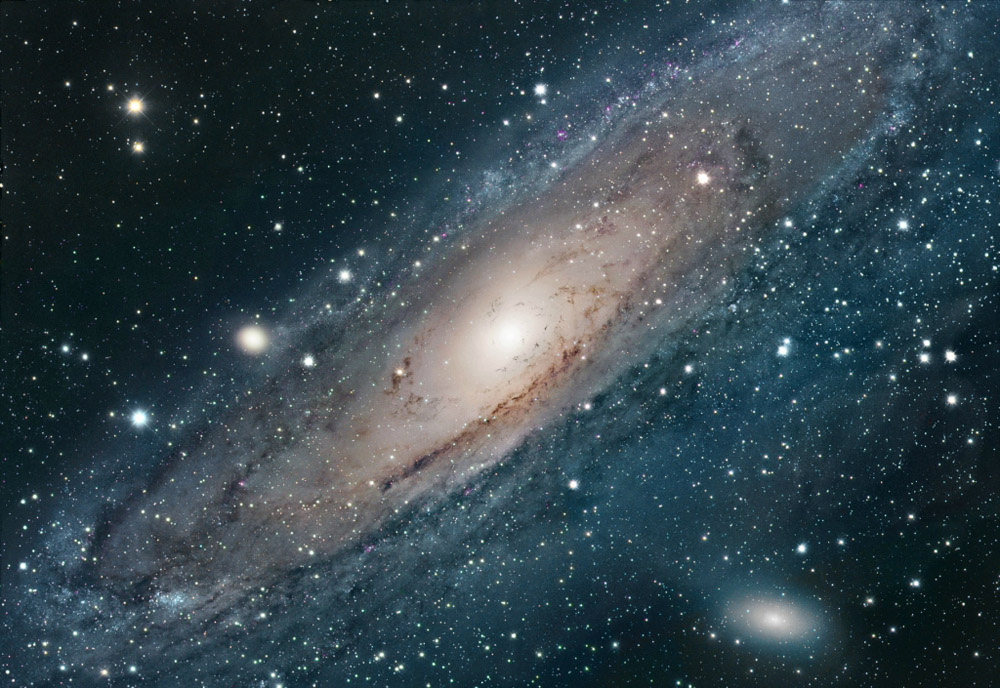
4. Andromeda Galaxy
The Andromeda Galaxy is the closest giant galaxy to our Milky Way. Most likely, our Galaxy looks about the same as the Andromeda Galaxy. These two galaxies dominate the Local Group of galaxies. The hundreds of billions of stars that make up the Andromeda Galaxy combine to produce a visible, diffuse glow. The individual stars in the image are actually stars in our Galaxy, located much closer to the distant object. The Andromeda Galaxy is often called M31 because it is the 31st object in Charles Messier's catalog of diffuse celestial objects.
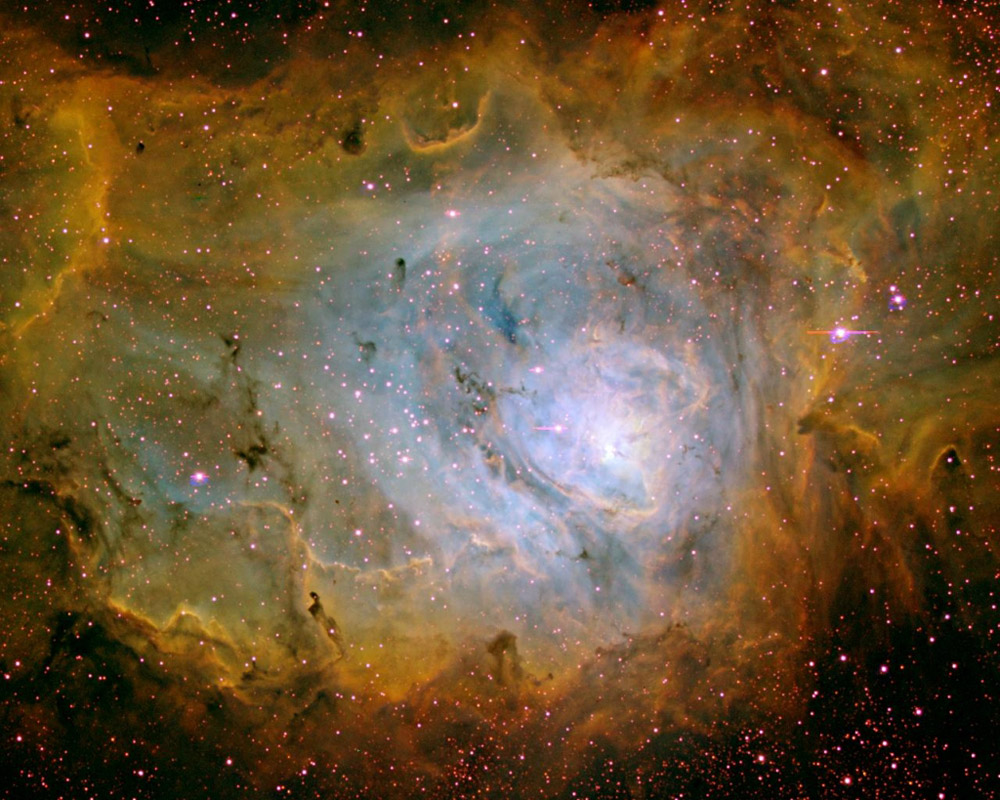
5. Lagoon Nebula
The bright Lagoon Nebula contains many different astronomical objects. Particularly interesting objects include a bright open star cluster and several active star forming regions. When viewed visually, the light from the cluster is lost against the background of the overall red glow caused by hydrogen emission, while the dark filaments arise from the absorption of light by dense layers of dust.
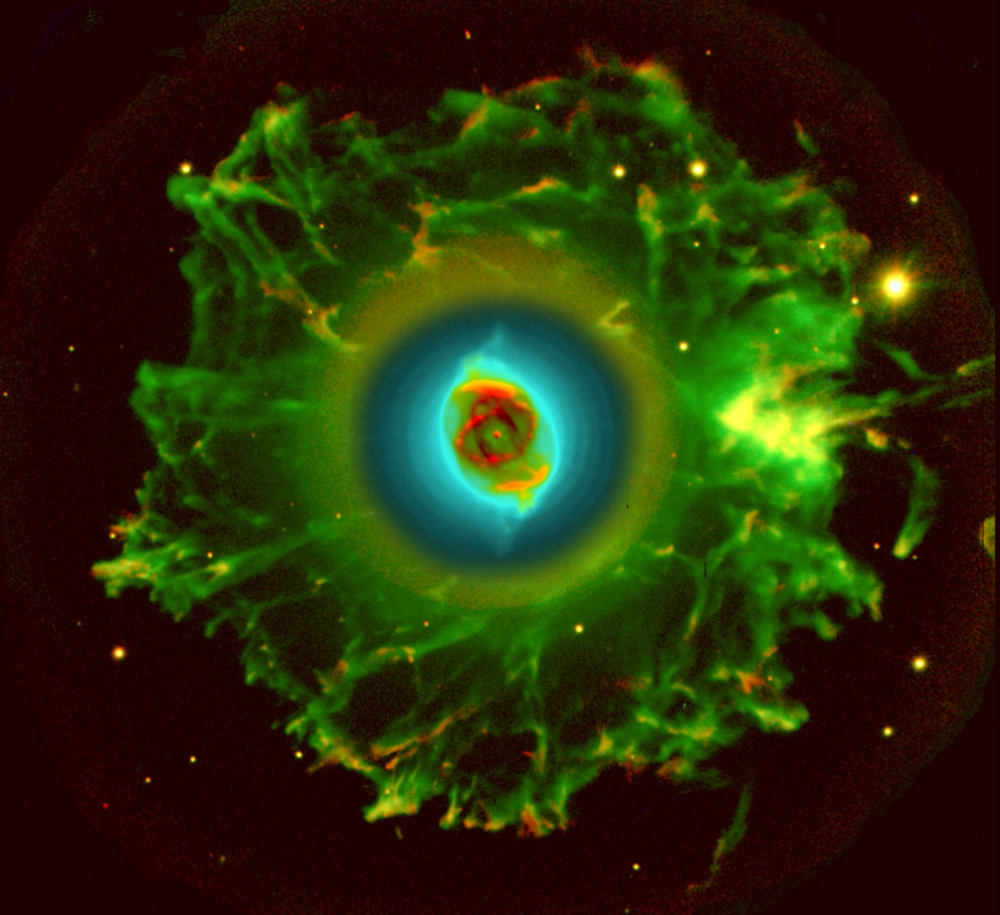
6. Cat's Eye Nebula (NGC 6543)
The Cat's Eye Nebula (NGC 6543) is one of the most famous planetary nebulae in the sky. Its haunting, symmetrical shape is visible in the central portion of this dramatic false-color image, specially processed to reveal a huge but very faint halo of gaseous material, some three light-years in diameter, that surrounds the bright, familiar planetary nebula.
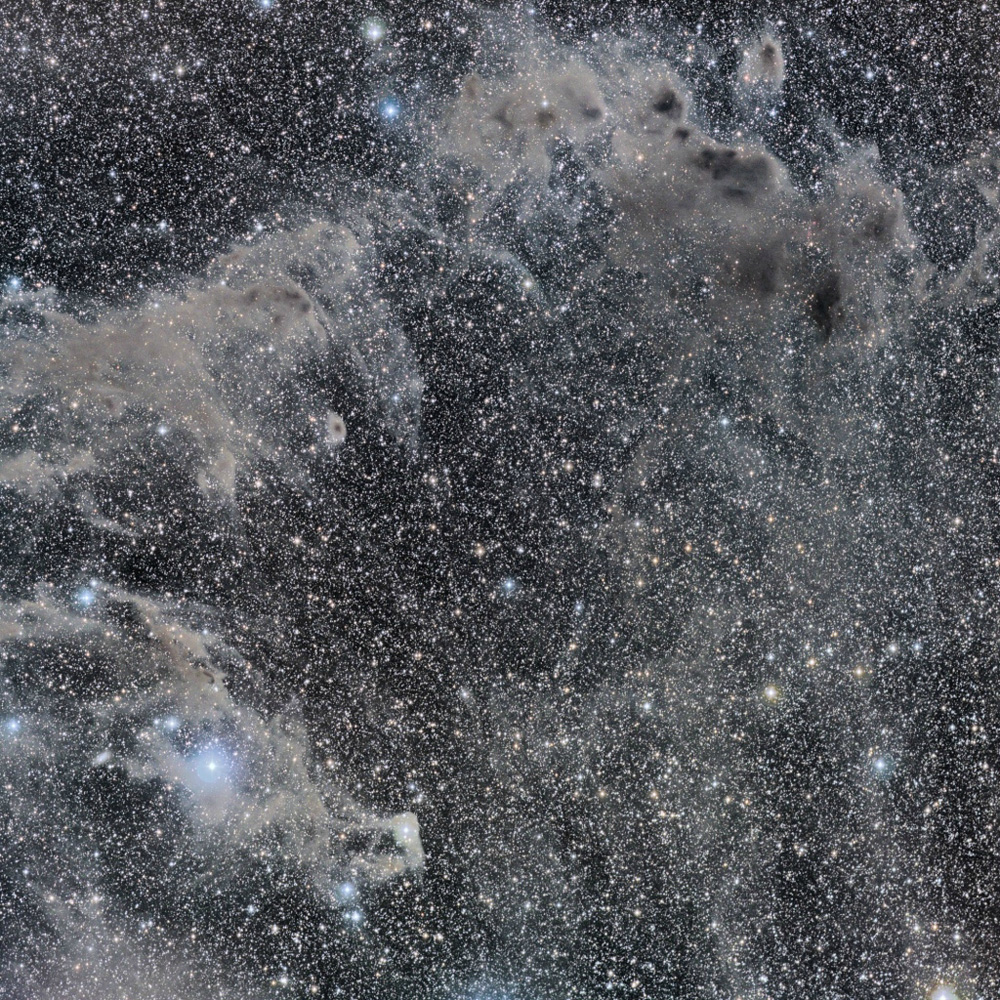
7. Small constellation Chameleon
The small constellation Chameleon is located near the south pole of the World. The picture reveals the amazing features of the modest constellation, which reveals many dusty nebulae and colorful stars. Blue reflection nebulae are scattered across the field.
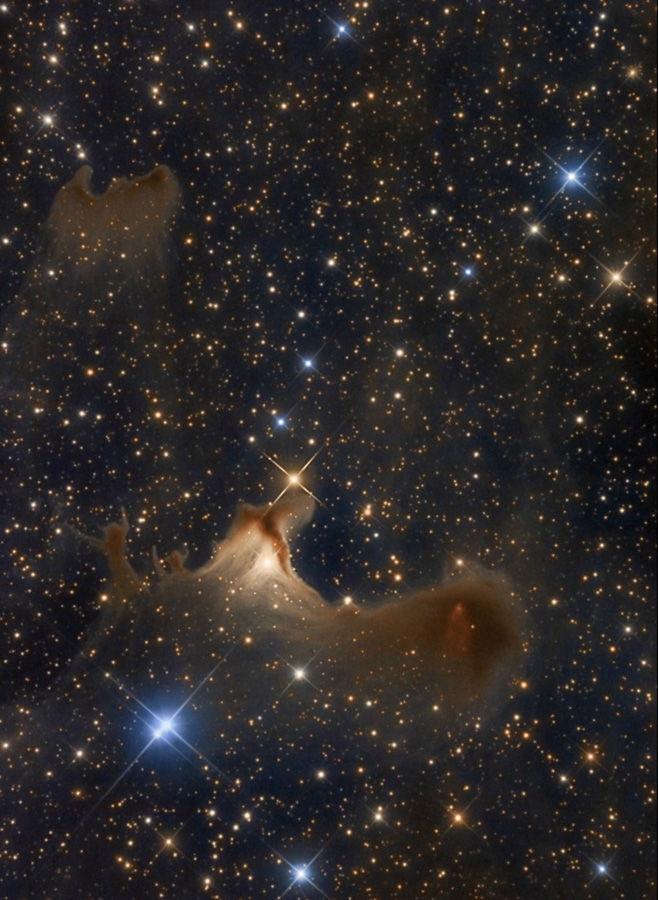
8. Nebula Sh2-136
Cosmic dust clouds glowing faintly with reflected starlight. Far from familiar places on planet Earth, they lurk on the edge of the Cephei Halo molecular cloud complex, 1,200 light-years away. Nebula Sh2-136, located near the center of the field, is brighter than other ghostly apparitions. Its size is more than two light years, and it is visible even in infrared light.

9. Horsehead Nebula
The dark, dusty Horsehead Nebula and the glowing Orion Nebula contrast in the sky. They are located 1,500 light years away in the direction of the most recognizable celestial constellation. And in today's remarkable composite photograph, the nebulae occupy opposite corners. The familiar Horsehead Nebula is a small dark cloud in the shape of a horse's head, silhouetted against a background of red glowing gas in the lower left corner of the picture.
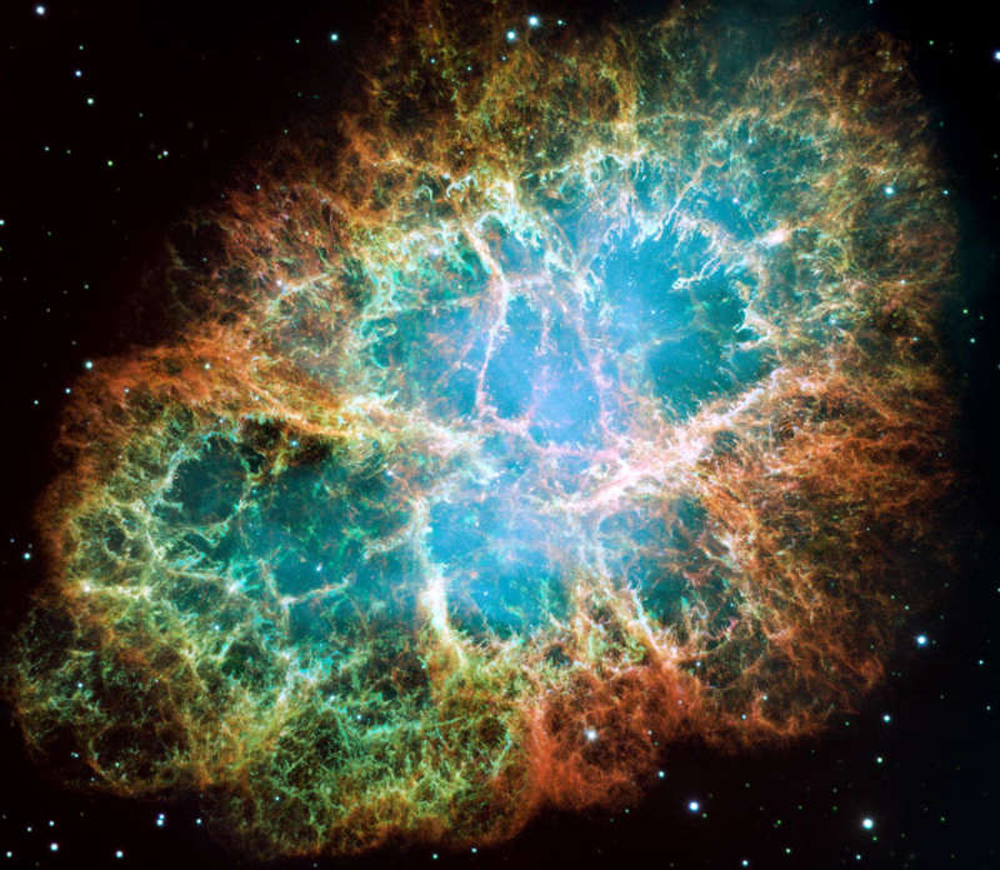
10. Crab Nebula
This confusion remained after the star exploded. The Crab Nebula is the result of a supernova explosion observed in 1054 AD. The supernova remnant is filled with mysterious filaments. The filaments are not just complex to look at. The extent of the Crab Nebula is ten light years. At the very center of the nebula is a pulsar - a neutron star with a mass equal to the mass of the Sun, which fits into an area the size of a small town.

11. Mirage from a gravitational lens
This is a mirage from a gravitational lens. The bright red galaxy (LRG) shown in this photograph has been distorted by its gravity to the light from a more distant blue galaxy. Most often, such a distortion of light leads to the appearance of two images of a distant galaxy, but in the case of a very precise superposition of the galaxy and the gravitational lens, the images merge into a horseshoe - an almost closed ring. This effect was predicted by Albert Einstein 70 years ago.

12. Star V838 Mon
For unknown reasons, in January 2002, the outer shell of the star V838 Mon suddenly expanded, making it the brightest star in the entire Milky Way. Then she became weak again, also suddenly. Astronomers have never seen a stellar flare like this before.

13. Birth of planets
How are planets formed? To try to find out, the Hubble Space Telescope was tasked with taking a closer look at one of the most interesting of all nebulae in the sky: the Great Orion Nebula. The Orion Nebula can be seen with the naked eye near the belt of the constellation Orion. The insets in this photo show numerous proplyds, many of them stellar nurseries that likely house forming planetary systems.
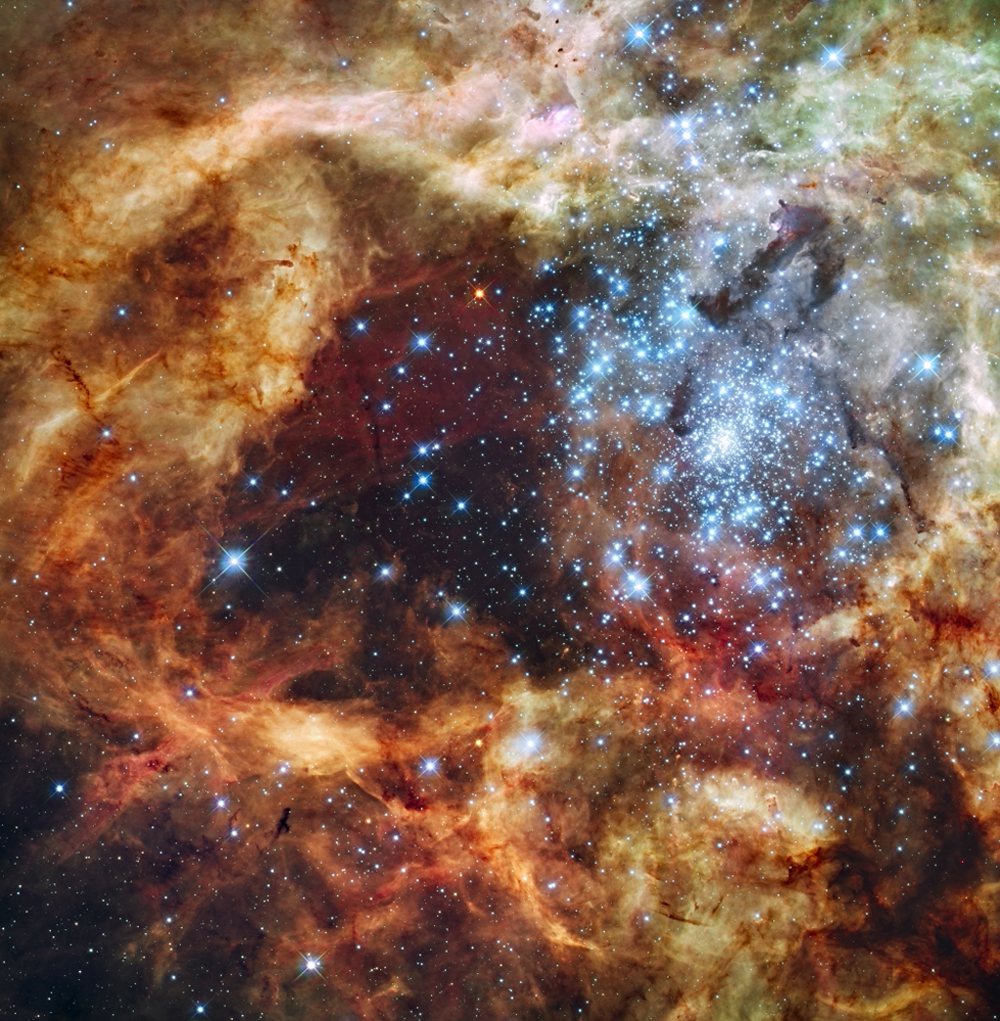
14. Star cluster R136
At the center of the star-forming region 30 Doradus lies a gigantic cluster of the largest, hottest, and most massive stars known to us. These stars form the R136 cluster, captured in this image taken in visible light by the upgraded Hubble Space Telescope.

Brilliant NGC 253 is one of the brightest spiral galaxies we see, yet one of the dustiest. Some call it the “Silver Dollar Galaxy” because it is shaped like that in a small telescope. Others simply call it the “Sculptor Galaxy” because it lies within the southern constellation Sculptor. This dusty galaxy is located 10 million light years away.
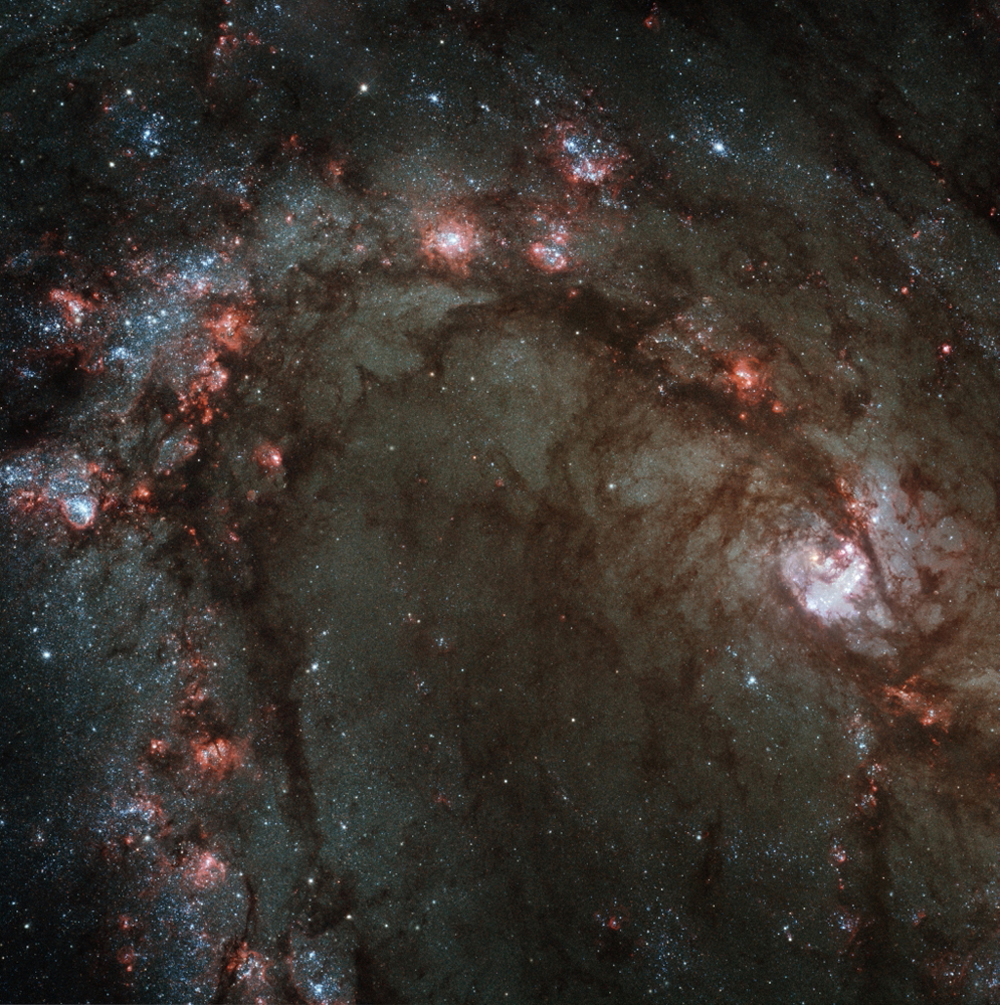
16. Galaxy M83
Galaxy M83 is one of the closest spiral galaxies to us. From the distance that separates us from her, equal to 15 million light years, she looks completely ordinary. However, if we take a closer look at the center of M83 using the largest telescopes, the region appears to be a turbulent and noisy place.
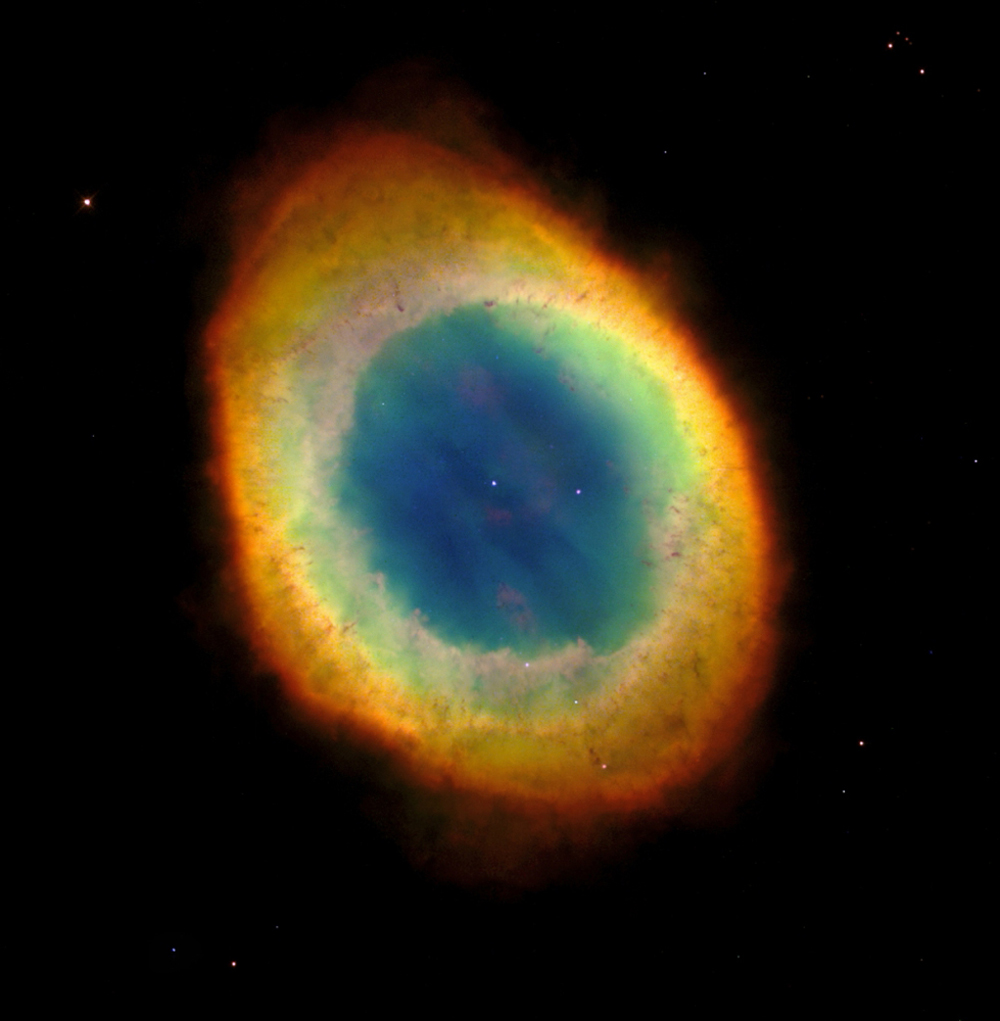
17. Ring Nebula
She really looks like a ring in the sky. Therefore, hundreds of years ago, astronomers named this nebula according to its unusual shape. The Ring Nebula is also designated M57 and NGC 6720. The Ring Nebula belongs to the class of planetary nebulae; these are gas clouds that emit stars similar to the Sun at the end of their lives. Its size exceeds the diameter. This is one of Hubble's early images.

18. Column and jets in the Carina Nebula
This cosmic column of gas and dust is two light years wide. The structure is located in one of the largest star-forming regions of our Galaxy, the Carina Nebula, which is visible in the southern sky and is 7,500 light-years away.
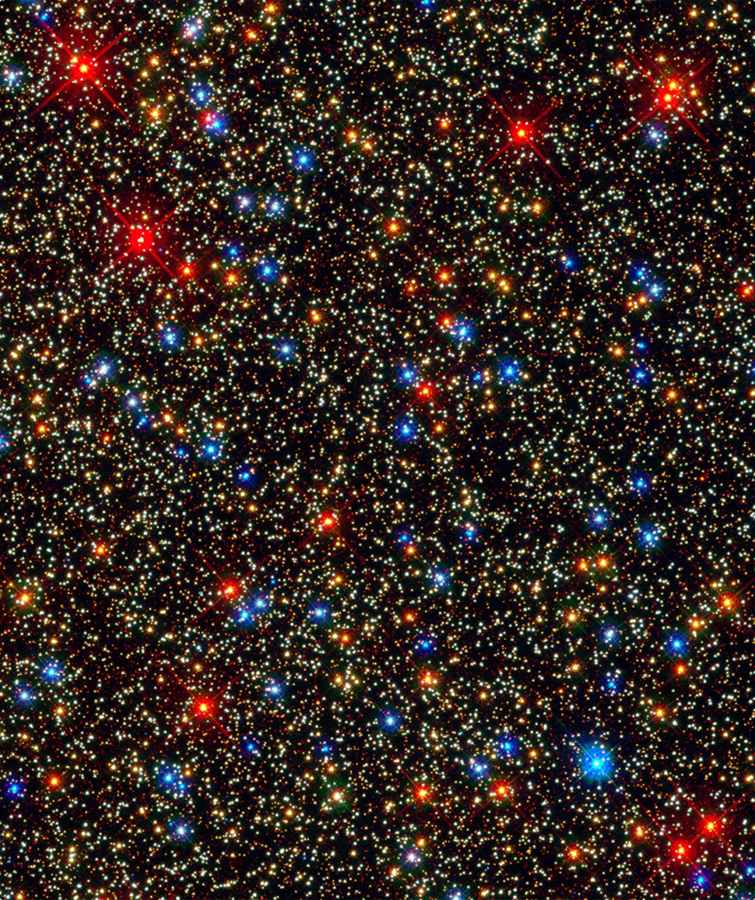
19. Center of the Omega Centauri globular cluster
At the center of the globular cluster Omega Centauri, the stars are packed ten thousand times more densely than the stars in the vicinity of the Sun. The image shows many faint yellow-white stars smaller than our Sun, several orange red giants, and the occasional blue star. If two stars suddenly collide, they can form one more massive star, or they can form a new binary system.
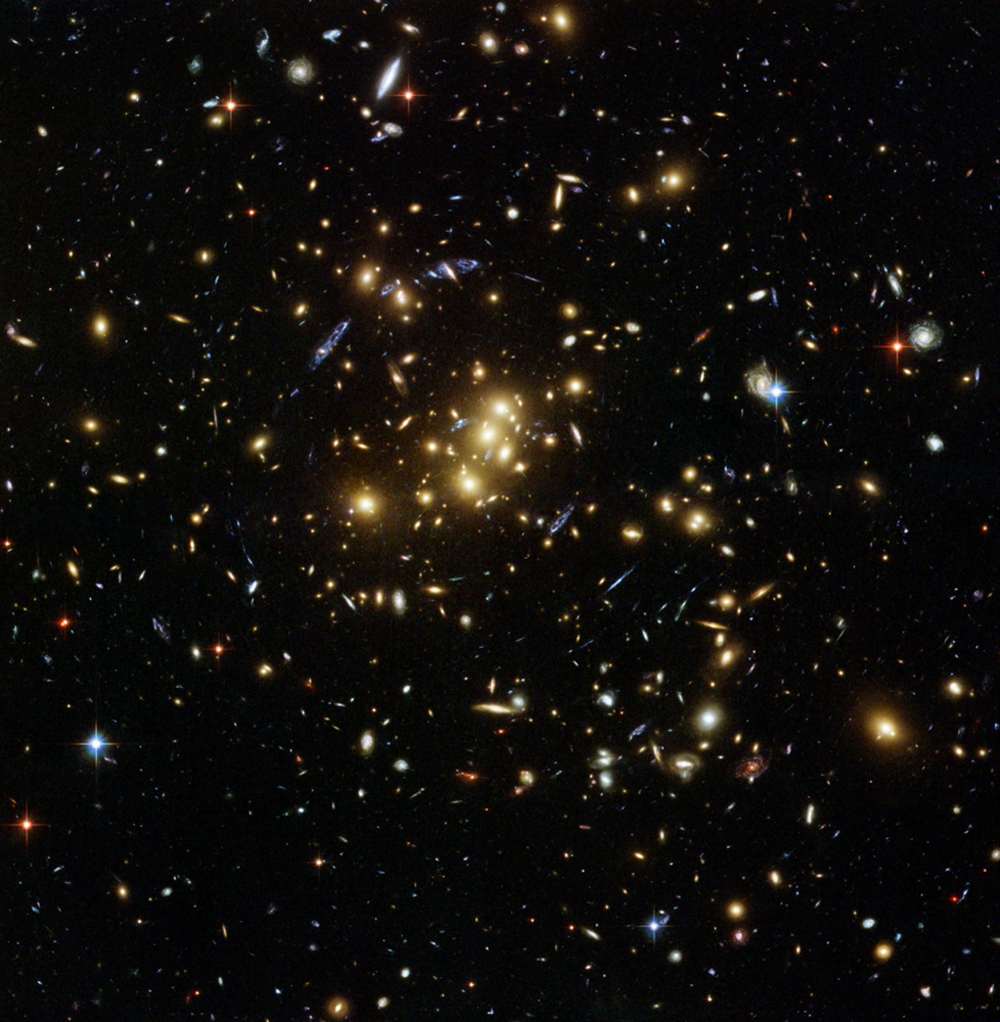
20. A giant cluster distorts and splits the image of the galaxy
Many of them are images of a single unusual, beady, blue ring-shaped galaxy that happens to be located behind a giant cluster of galaxies. According to recent research, in total, at least 330 images of individual distant galaxies can be found in the picture. This stunning photograph of the galaxy cluster CL0024+1654 was taken by the NASA Space Telescope. Hubble in November 2004.
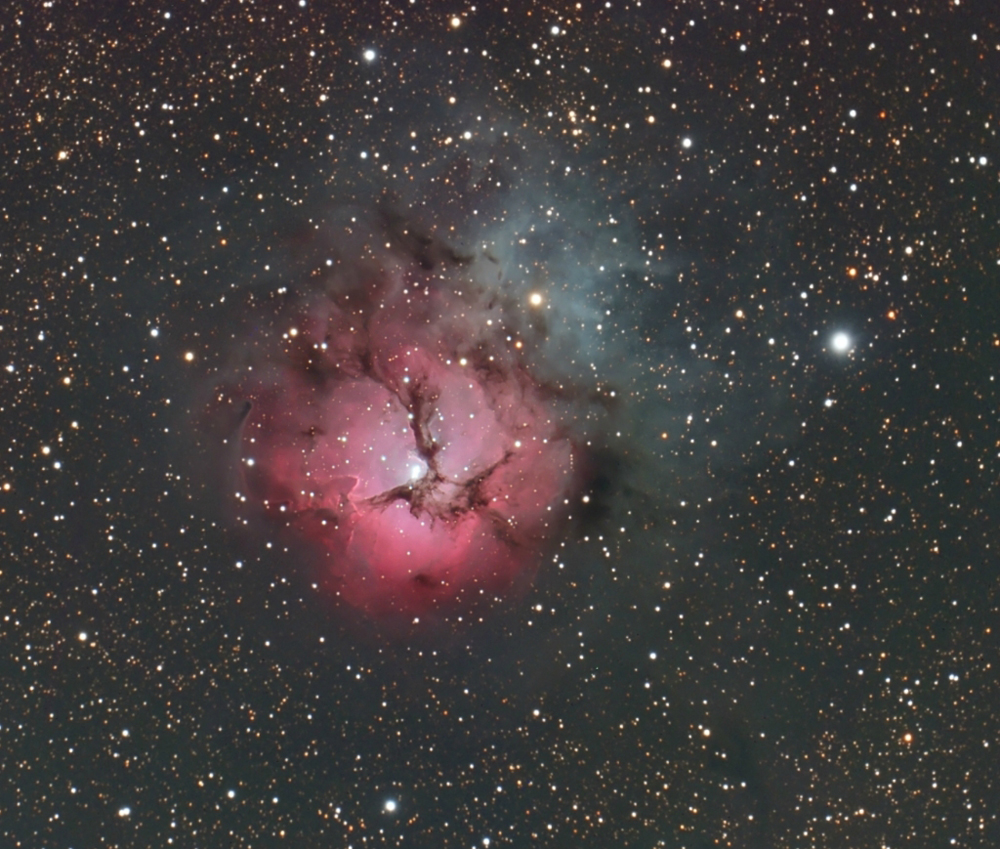
21. Trifid Nebula
The beautiful multi-colored Trifid Nebula allows you to explore cosmic contrasts. Also known as M20, it lies about 5,000 light-years away in the nebula-rich constellation Sagittarius. The size of the nebula is about 40 light years.
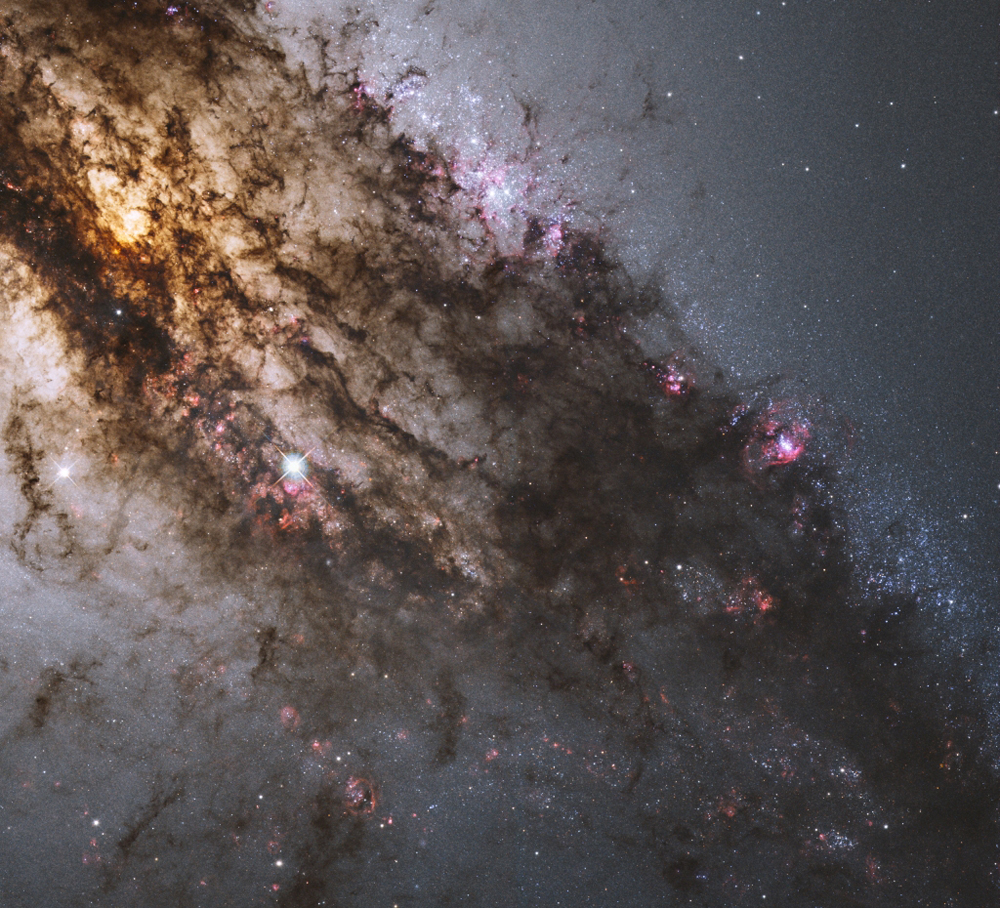
22. Centaurus A
A fantastic array of young blue star clusters, giant glowing gas clouds and dark dust lanes surround the central region of the active galaxy Centaurus A. Centaurus A is close to Earth, 10 million light years away.

23. Butterfly Nebula
Bright clusters and nebulae in Earth's night sky are often named after flowers or insects, and NGC 6302 is no exception. The central star of this planetary nebula is exceptionally hot: its surface temperature is about 250 thousand degrees Celsius.
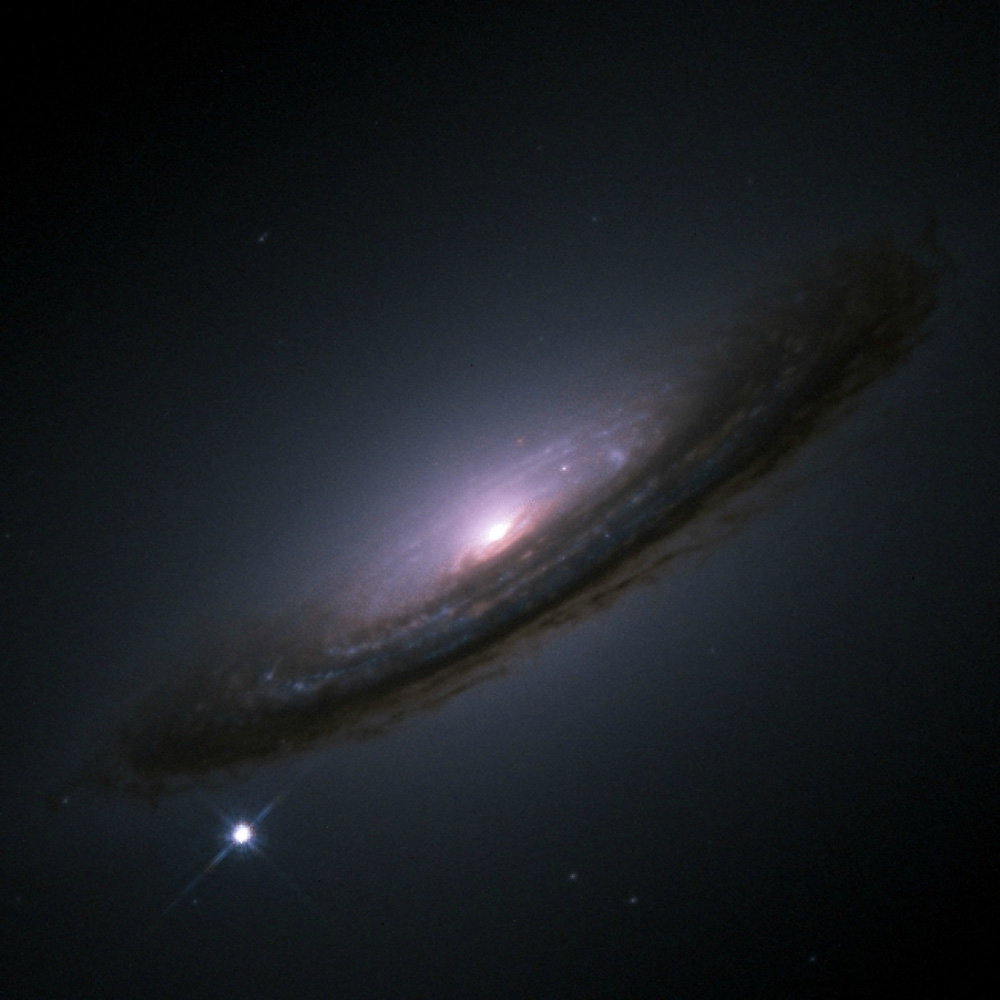
24. Supernova
An image of a supernova that exploded in 1994 on the outskirts of a spiral galaxy.
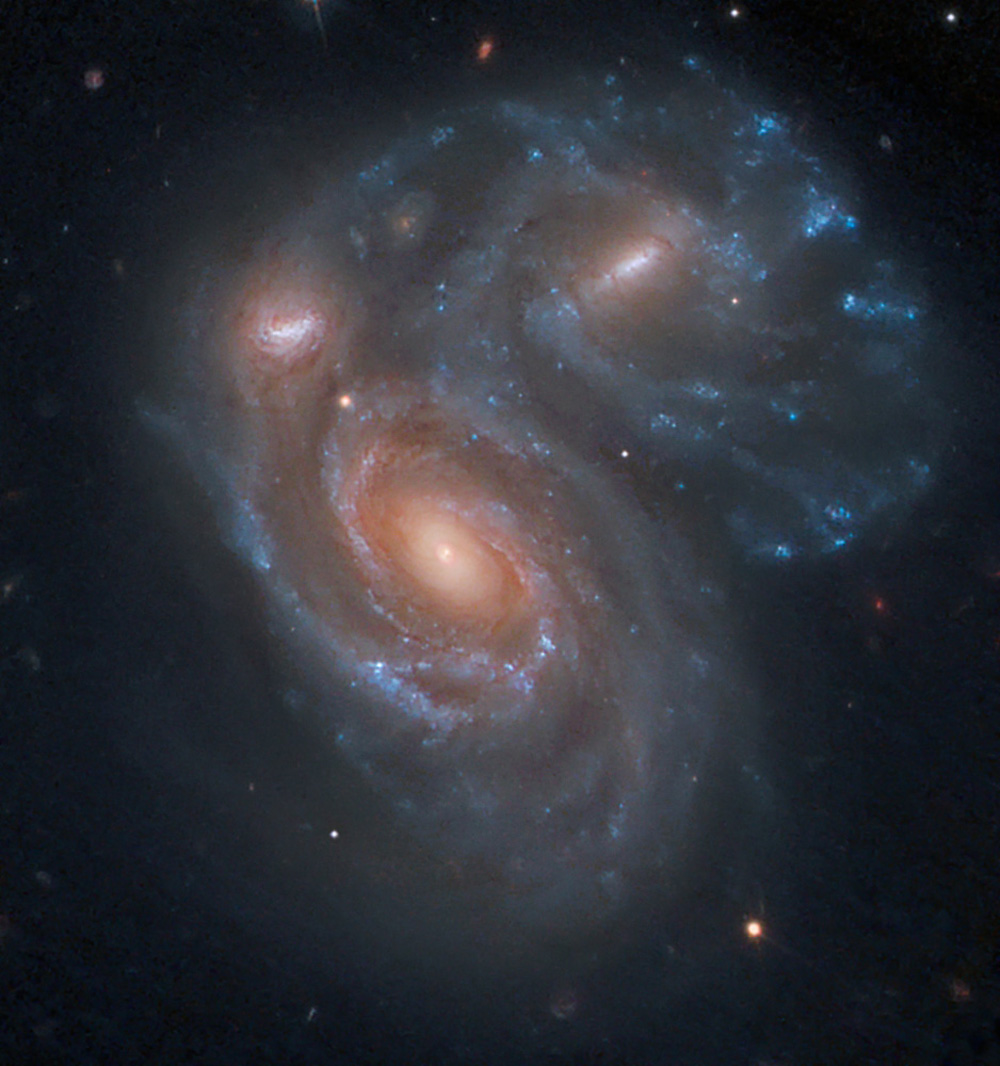
25. Two colliding galaxies with merging spiral arms
This remarkable cosmic portrait shows two colliding galaxies with merging spiral arms. Above and to the left of the large spiral galaxy pair NGC 6050 can be seen a third galaxy that is also likely involved in the interaction. All of these galaxies are located about 450 million light-years away in the Hercules cluster of galaxies. At this distance, the image covers an area of more than 150 thousand light years. And although this appearance seems quite unusual, scientists now know that collisions and subsequent mergers of galaxies are not uncommon.
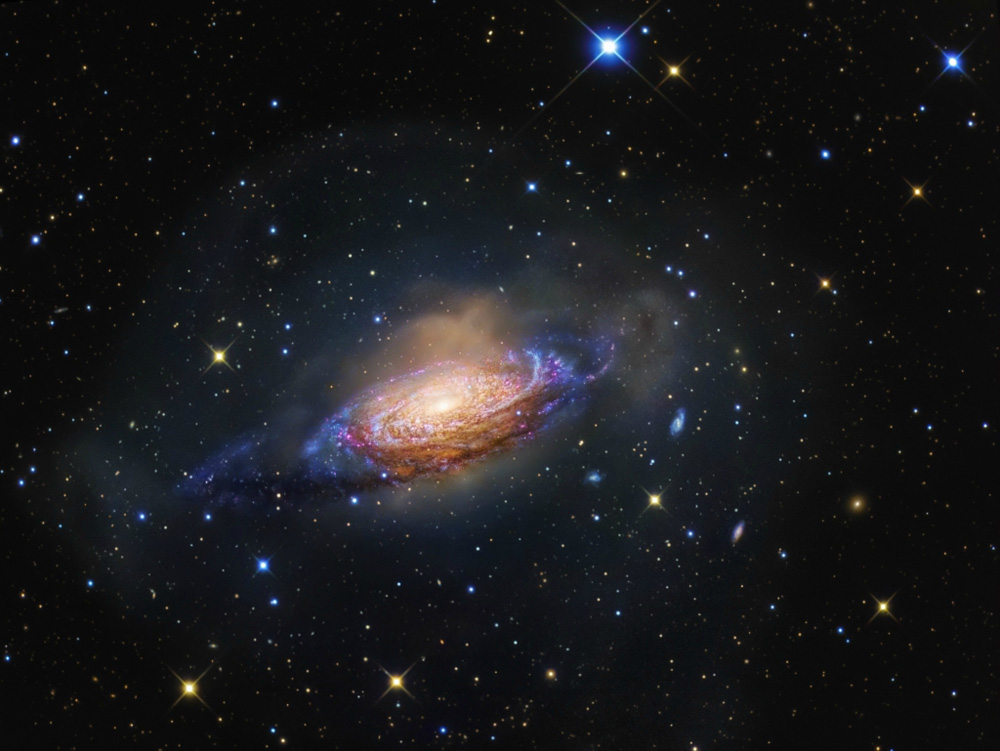
26. Spiral Galaxy NGC 3521
Spiral galaxy NGC 3521 lies just 35 million light-years away in the direction of the constellation Leo. The galaxy, which extends over 50,000 light-years, has features such as jagged, irregular spiral arms festooned with dust, pinkish star-forming regions and clusters of young bluish stars.
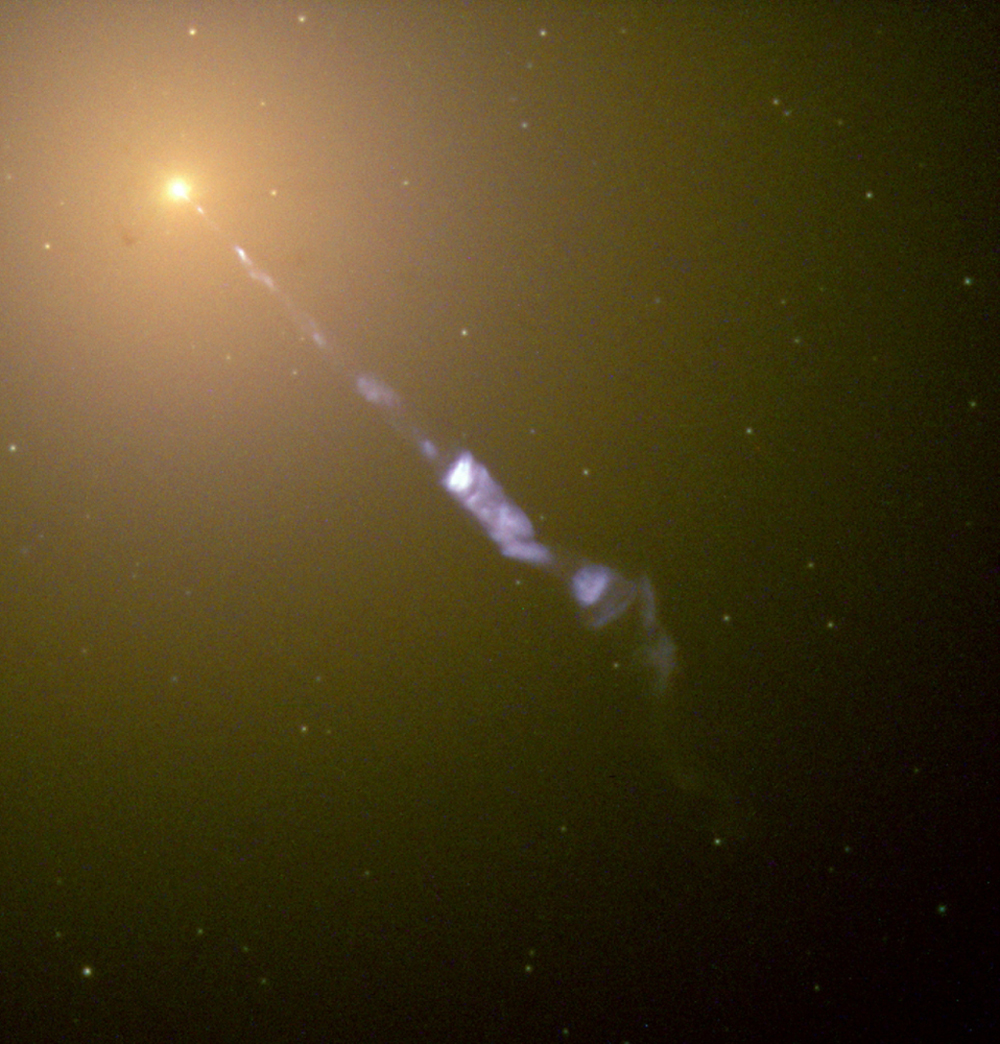
27. Jet structure details
Although this unusual emission was first noticed in the early twentieth century, its origin is still the subject of debate. The image shown above, taken in 1998 by the Hubble Space Telescope, clearly shows details of the jet's structure. The most popular hypothesis suggests that the source of the ejection was heated gas orbiting a massive black hole at the center of the galaxy.

28. Sombrero Galaxy
Galaxy M104's appearance resembles a hat, which is why it is called the Sombrero Galaxy. The image shows distinct dark lanes of dust and a bright halo of stars and globular clusters. The reasons why the Sombrero Galaxy looks like a hat are the unusually large central stellar bulge and the dense dark lanes of dust located in the galaxy's disk, which we see almost edge-on.

29. M17: close-up view
Formed by stellar winds and radiation, these fantastic wave-like formations are found in the M17 (Omega Nebula) nebula and are part of a star-forming region. The Omega Nebula is located in the nebula-rich constellation Sagittarius and is 5,500 light-years away. The patchy clumps of dense, cold gas and dust are illuminated by radiation from the stars in the image at top right and could become sites of star formation in the future.
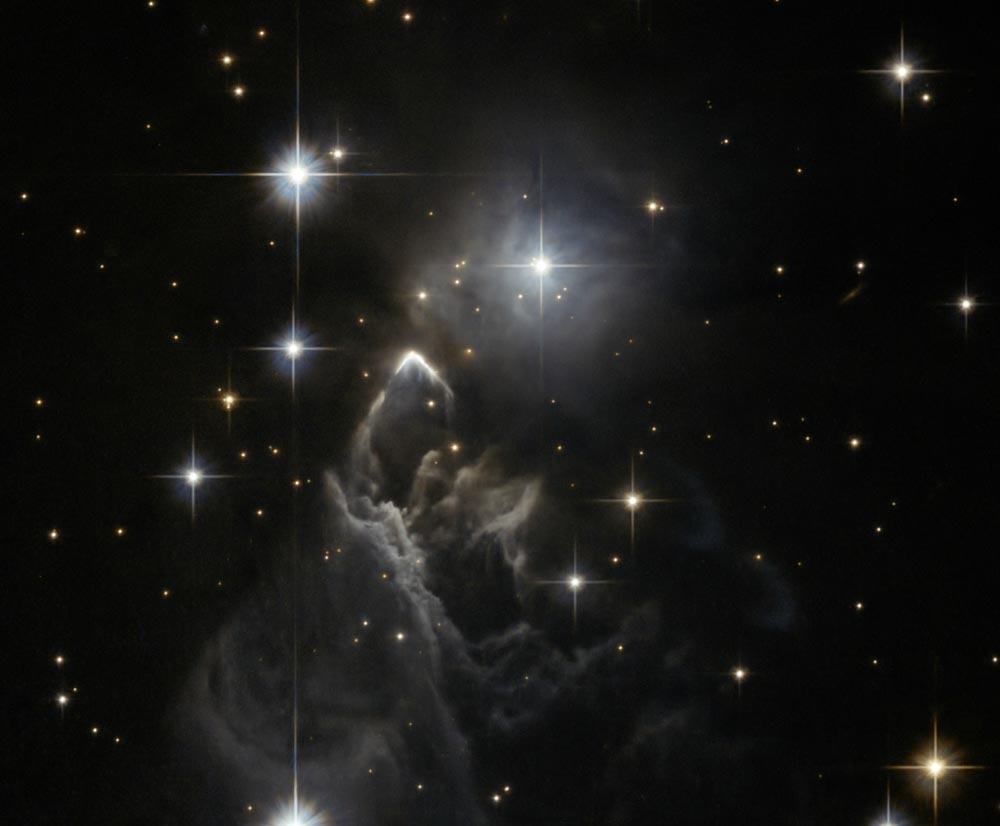
30. Nebula IRAS 05437+2502
What does the IRAS 05437+2502 nebula illuminate? There is no exact answer yet. Particularly puzzling is the bright, inverted V-shaped arc that outlines the top edge of the mountain-like clouds of interstellar dust near the center of the image. Overall, this ghost-like nebula includes a small star-forming region filled with dark dust. It was first spotted in infrared images taken by the IRAS satellite in 1983. Shown here is a remarkable, recently released image from the Hubble Space Telescope. Although it shows many new details, the cause of the bright, clear arc could not be determined.
Published: January 27, 2015 at 05:19
1. Abell 68's gravitational field surrounding this large group of galaxies serves as a natural cosmic lens that makes light coming from very distant galaxies behind the field brighter and larger. Reminiscent of a “distorted mirror” effect, the lens creates a fantastic landscape of arcing patterns and mirror reflections of rear galaxies. The closest group of galaxies is two billion light years away, and the images reflected through the lens come from galaxies that are even further away. In this photo above left, the image of the spiral galaxy has been stretched and mirrored. A second, less distorted image of the same galaxy is to the left of a large, bright elliptical galaxy. In the upper right corner of the photo is another amazing detail that is not related to the effect of gravitational lenses. What appears to be crimson liquid dripping from the galaxy is, in fact, a phenomenon called "tidal stripping." When a galaxy passes through a field of dense intergalactic gas, the gas that accumulates inside the galaxy rises and heats up. (NASA, ESA, and the Hubble Heritage/ESA-Hubble Collaboration)
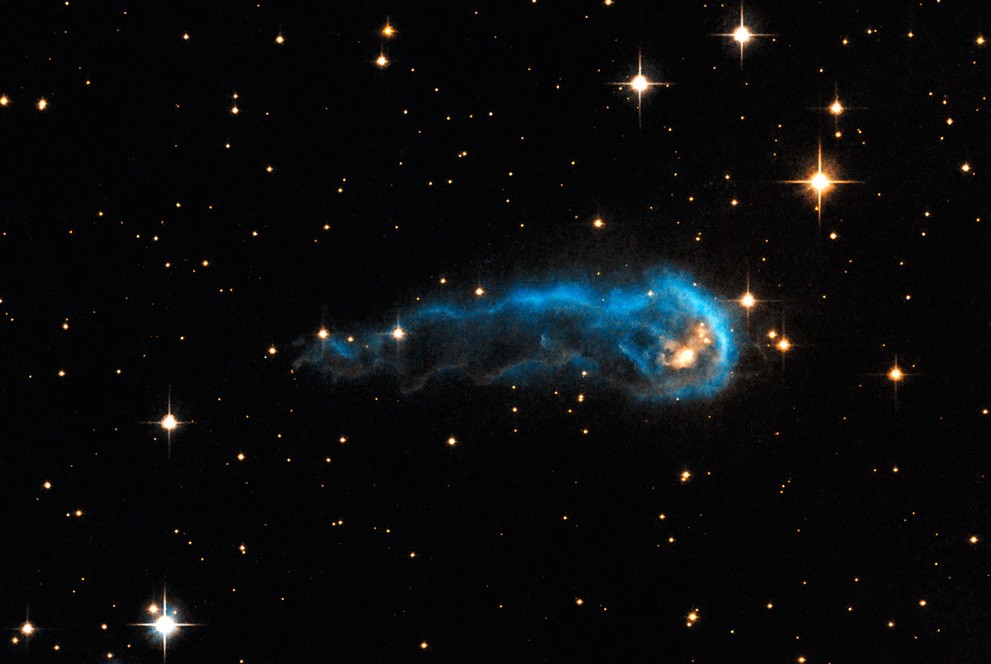
2. A clump of interstellar gas and dust, located at a distance of one light year, resembles a huge caterpillar. Towards the right edge of the photograph are obstacles - these are 65 of the brightest and hottest O-class stars known to us, located at a distance of fifteen light years from the clump. These stars, as well as another 500 less luminous but still bright class B stars, form the so-called “Association of Class OB2 Cygnus Stars.” The caterpillar-like clump, called IRAS 20324+4057, is a protostar in its earliest stages of development. It is still in the process of collecting material from the gas enveloping it. However, the radiation emanating from Cygnus OB2 destroys this shell. Protostars in this region will eventually become young stars with a final mass of about one to ten times the mass of our Sun, but if destructive radiation from nearby bright stars destroys the gas shell before the protostars gain the required mass, their final masses will be reduced. (NASA, ESA, the Hubble Heritage Team - STScI/AURA, and IPHAS)
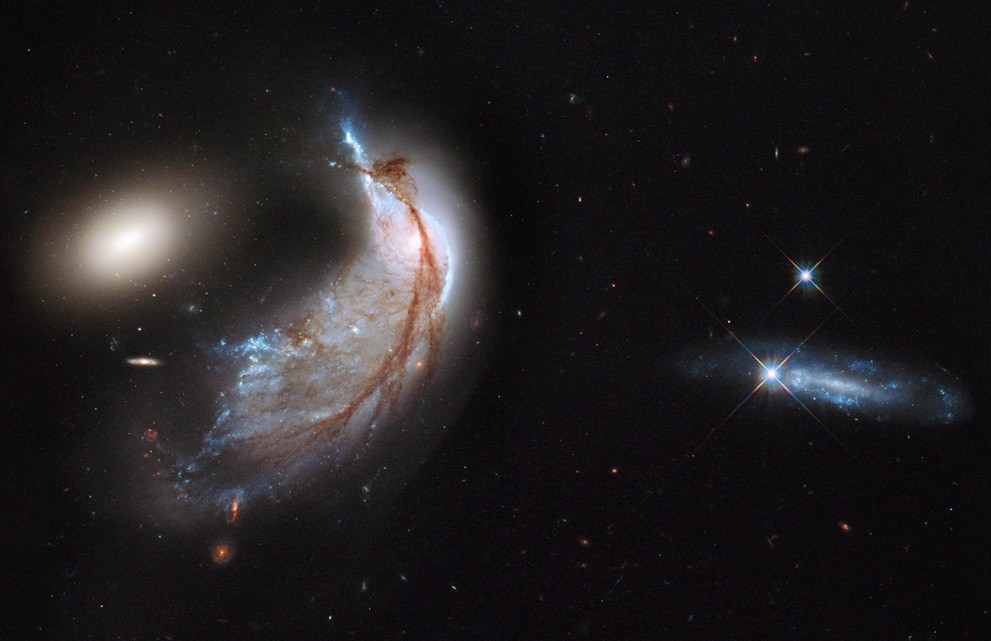
3. This pair of interacting galaxies is collectively called Arp 142. These include the star-forming spiral galaxy NGC 2936 and the elliptical galaxy NGC 2937. The orbits of the stars in NGC 2936 were once part of a flat spiral disk, but due to gravitational connections with another galaxy has fallen into disarray. This disorder distorts the orderly spiral of the galaxy; interstellar gas swells into giant tails. Gas and dust from the interior of the galaxy NGC 2936 are compressed when colliding with another galaxy, which triggers the process of star formation. Elliptical galaxy NGC 2937 resembles a dandelion of stars with some gas and dust remaining. The stars inside the galaxy are mostly old, as evidenced by their reddish color. There are no blue stars there, which would prove the process of their recent formation. Arp 142 is located 326 million light years away in the southern hemisphere constellation Hydra. (NASA, ESA, and the Hubble Heritage Team - STScI/AURA)
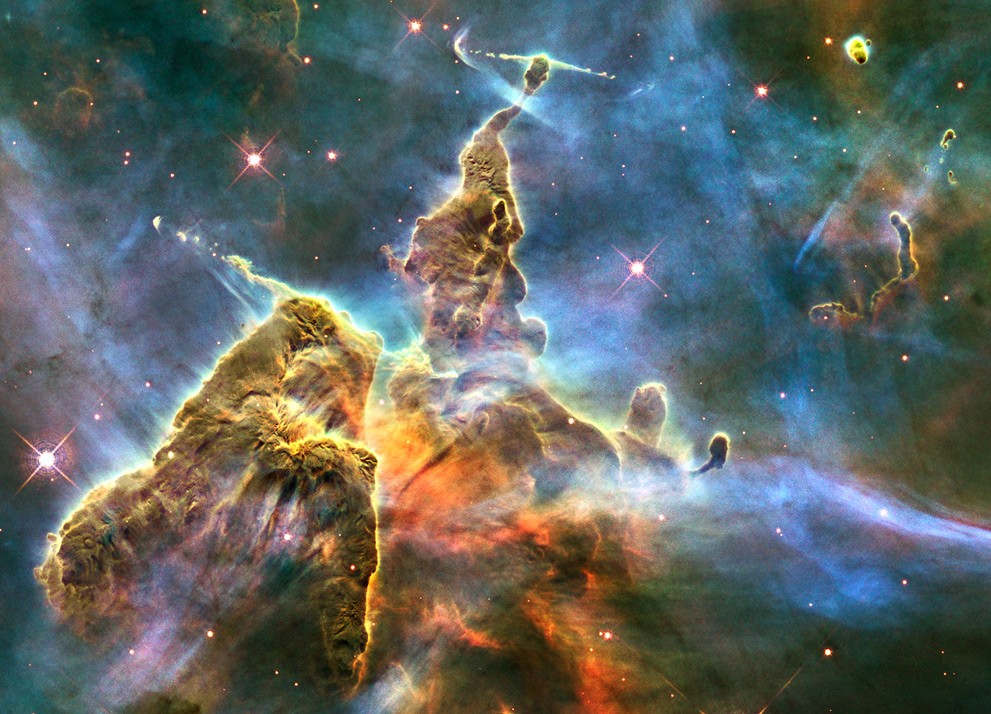
4. Star forming region Carina Nebula. What appears to be a cloud-shrouded mountain peak is actually a column of gas and dust three light years high, gradually being eaten away by light from nearby bright stars. The pillar, located about 7,500 light years away, is also collapsing from the inside as young stars growing inside it release gas vapors. (NASA, ESA, and M. Livio and the Hubble 20th Anniversary Team, STScI)
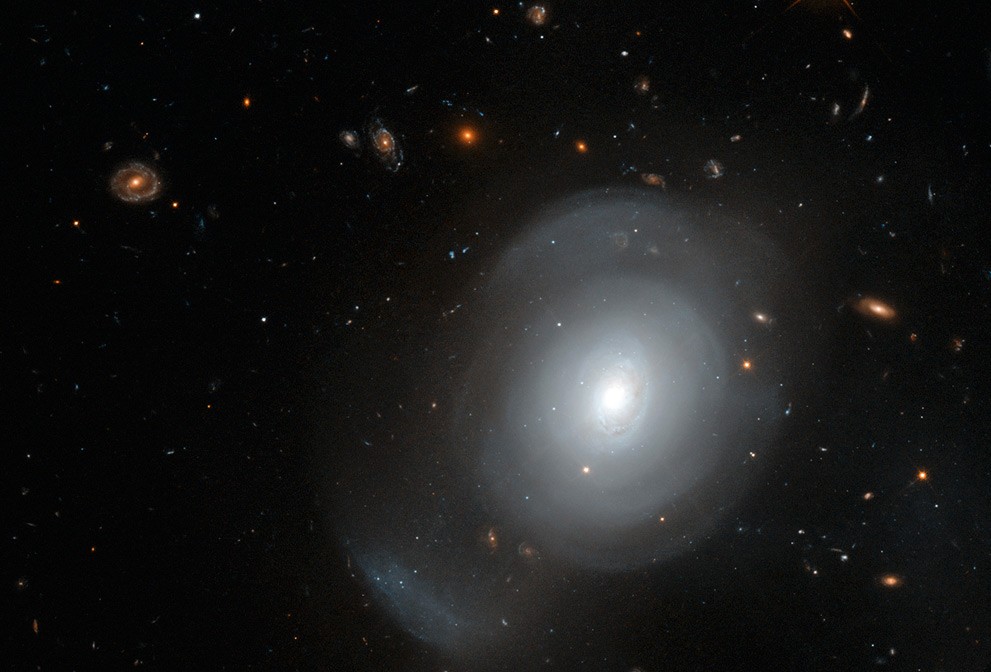
5. The beautiful petal-shaped steps of the galaxy PGC 6240 are captured in photographs taken by the Hubble Telescope. They are set against a sky full of distant galaxies. PGC 6240 is an elliptical galaxy located 350 million years away in the southern hemisphere constellation Hydra. In its orbit there are a large number of globular star clusters, consisting of both young and old stars. Scientists believe this is the result of a recent galactic merger. (ESA/Hubble and NASA)

6. Photo illustration of the brilliant spiral galaxy M106. This image of M106 only contains the internal structure around the ring and core. (NASA, ESA, the Hubble Heritage Team - STScI/AURA, and R. Gendler for the Hubble Heritage Team)
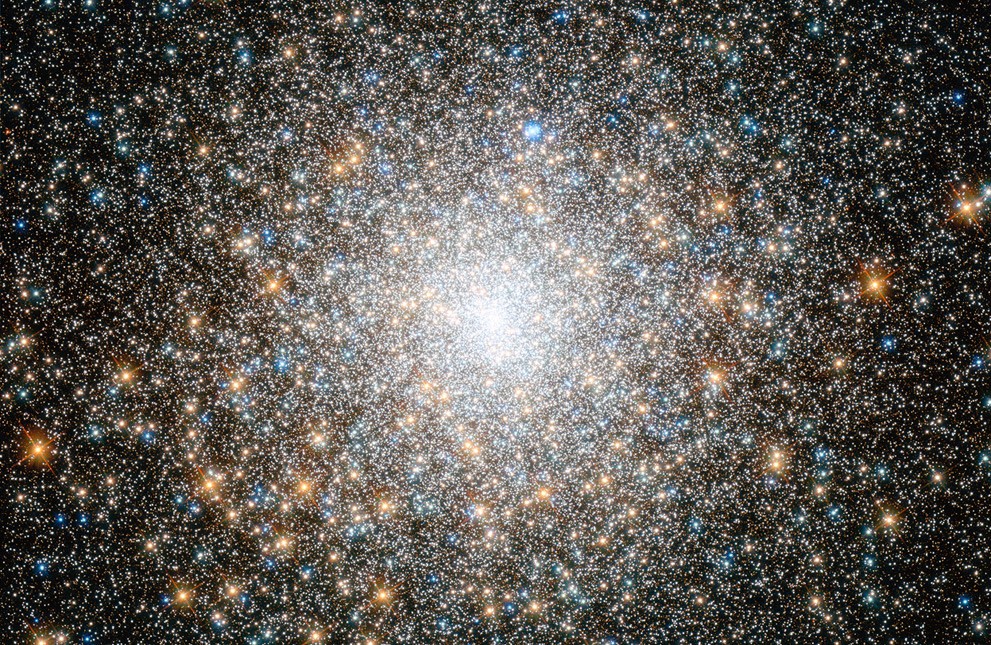
7. The globular star cluster Messier 15 is located about 35,000 light years away in the constellation Pegasus. It is one of the oldest clusters, about 12 billion years old. The photograph shows both very hot blue stars and cooler yellow stars swirling together, clustering most tightly around the cluster's bright center. Messier 15 is one of the densest globular star clusters. It was the first known cluster to reveal a planetary nebula with a rare type of black hole at its center. This photograph is compiled from Hubble telescope images in the ultraviolet, infrared and optical parts of the spectrum. (NASA, ESA)

8. The legendary Horsehead Nebula has been mentioned in astronomy books for over a century. In this panorama, the nebula appears in a new light, in the infrared. The nebula, unclear in optical light, now appears transparent and ethereal, but with a clear shadow. The illuminated rays around the upper dome are illuminated by the constellation Orion, a young five-star system visible near the edge of the photo. Powerful ultraviolet light from one of these bright stars is slowly dissipating the Nebula. Two forming stars emerge from their birthplace near the upper ridge of the Nebula. (NASA, ESA, and the Hubble Heritage Team - STScI/AURA)
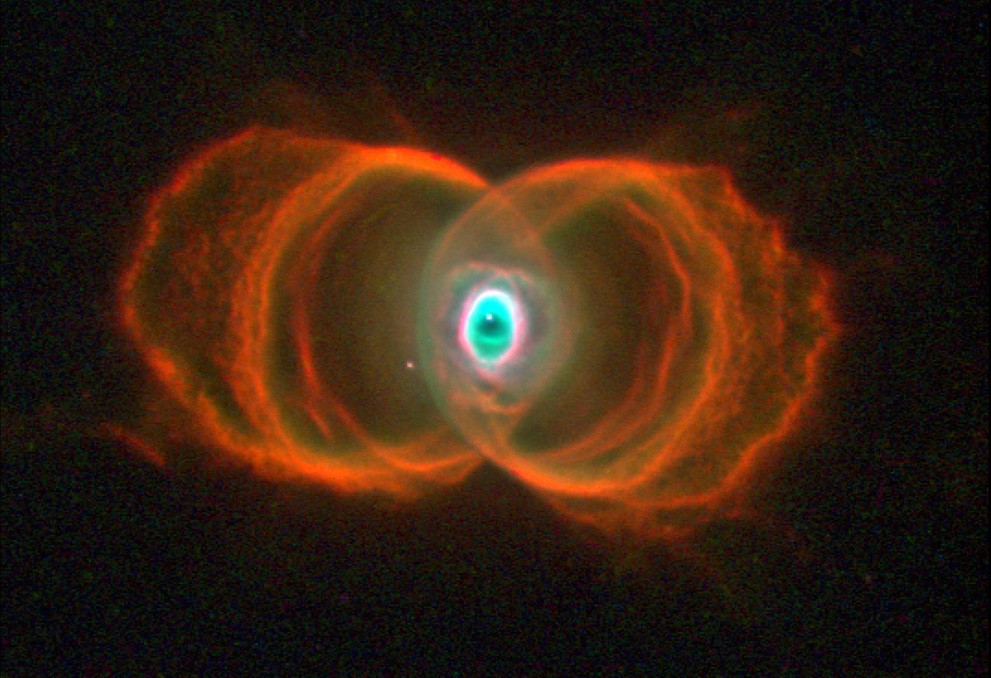
9. A snapshot of the young planetary nebula MyCn18 shows that this object It has the shape of an hourglass with a pattern on the walls. Planetary nebula is the luminous remnant of a dying star like the Sun. These photos are very interesting because... they help to understand the hitherto unknown details of the ejection of stellar matter that accompanies the slow destruction of stars. (Raghvendra Sahai and John Trauger, JPL, the WFPC2 science team, and NASA)
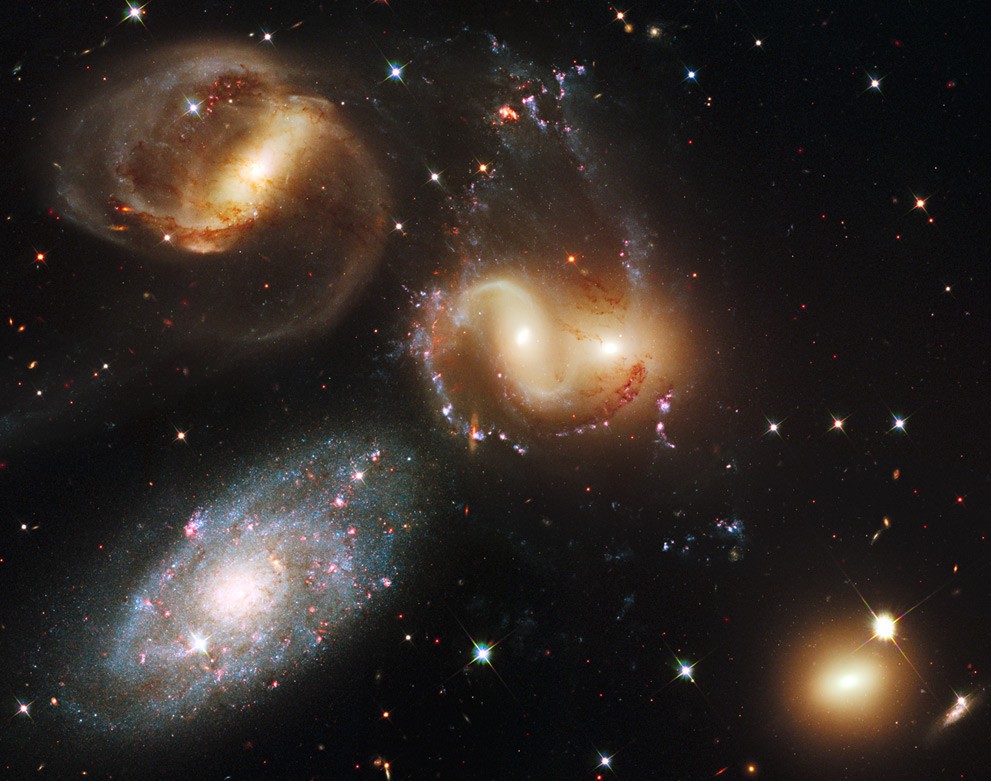
10. The Stephen's Quintet galaxy group is located in the constellation Pegasus at a distance of 290 million light years. Four of the five galaxies are very close to each other. It seems that the most bright galaxy NGC 7320, lower left, is also part of the group, but is actually 250 million light years closer than the others. (NASA, ESA, and the Hubble SM4 ERO Team)
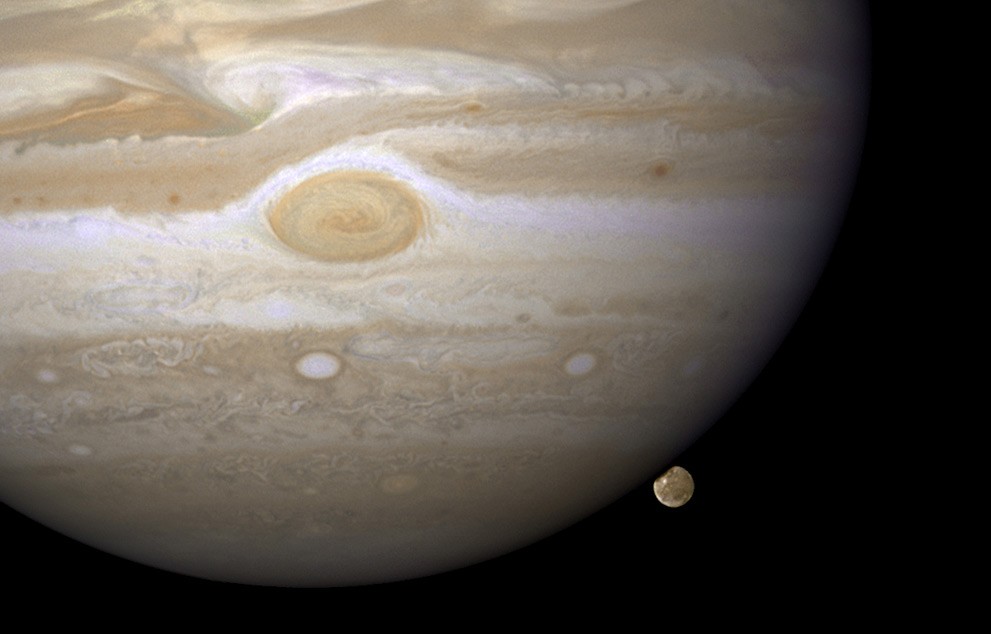
11. The Hubble telescope captured Ganymede, a satellite of Jupiter, before it disappeared behind the huge planet. Ganymede orbits Jupiter in seven days. Ganymede, made of rock and ice, is the most... large satellite in our solar system; even more than the planet Mercury. But compared to Jupiter itself big planet, Ganymede looks like a dirty snowball. Jupiter is so large that only part of its southern hemisphere fits in this photo. The Hubble image is so clear that astronomers can see features on Ganymede's surface, most notably the white Tros impact crater, and a system of rays, bright streams of material, shooting out from the crater. (NASA, ESA, and E. Karkoschka, University of Arizona)
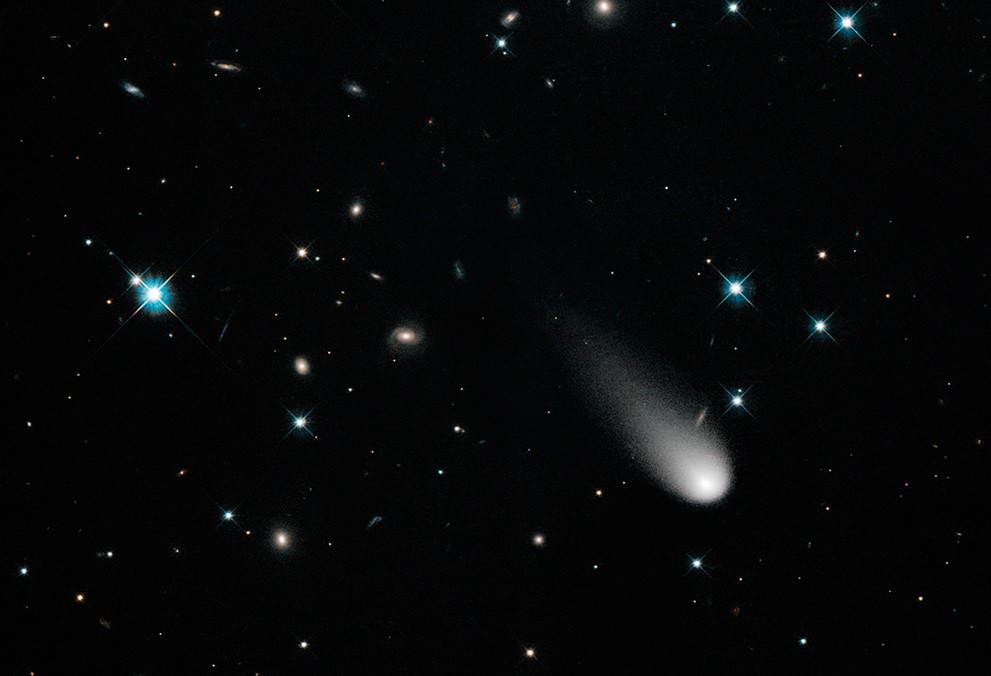
12. Comet ISON circling the Sun before its destruction. In this photo, ISON appears to be flying around a huge number of galaxies behind and a small number of stars ahead. Discovered in 2013, the small lump of ice and rock (2 km in diameter) was hurtling toward the Sun to pass at a distance of about 1 million kilometers from the Sun. The gravitational forces were too strong for the comet, and it disintegrated. (NASA, ESA, and the Hubble Heritage Team, STScI/AURA)

13. Light echo of the star V838 Monoceros. Shown here is a spectacular illumination of the surrounding dust cloud, called a light echo, that brightened for several years after the star suddenly shone for a few weeks in 2002. Illumination of the interstellar dust comes from the red supergiant star in the middle of the image, which suddenly erupted in light three years ago, like a light bulb turning on in a dark room. The dust surrounding V838 Monoceros may have been ejected from the star during a similar previous outburst in 2002. (NASA, ESA, and The Hubble Heritage Team, STScI/AURA)
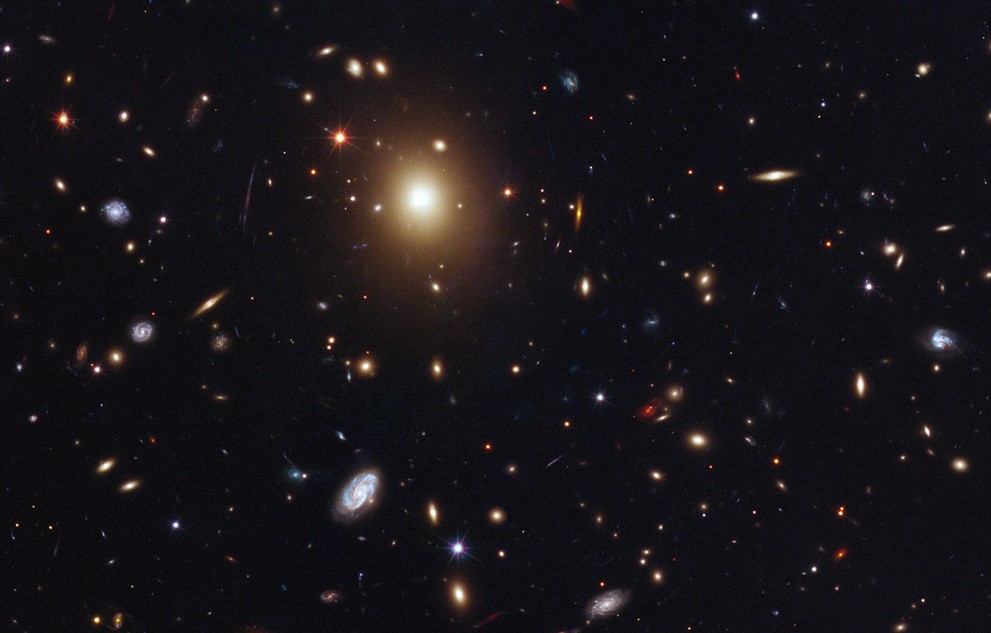
14. Abell 2261. The giant elliptical galaxy at the center is the brightest and most massive part of the galaxy cluster Abell 2261. Located at a distance of just over one million light years, the diameter of the galaxy is about 10 times the diameter of the Milky Way galaxy. A bloated galaxy is an unusual type of galaxy with a diffuse core filled with a thick haze of starlight. Typically, astronomers assume that light is concentrated around a black hole at the center. Hubble observations show that the galaxy's swollen core, estimated at about 10,000 light-years across, is the largest ever seen. The gravitational influence on the light coming from galaxies located behind can make the image of photographs stretched or blurred, creating the so-called “gravitational lensing effect.” (NASA, ESA, M. Postman, STScI, T. Lauer, NOAO, and the CLASH team)
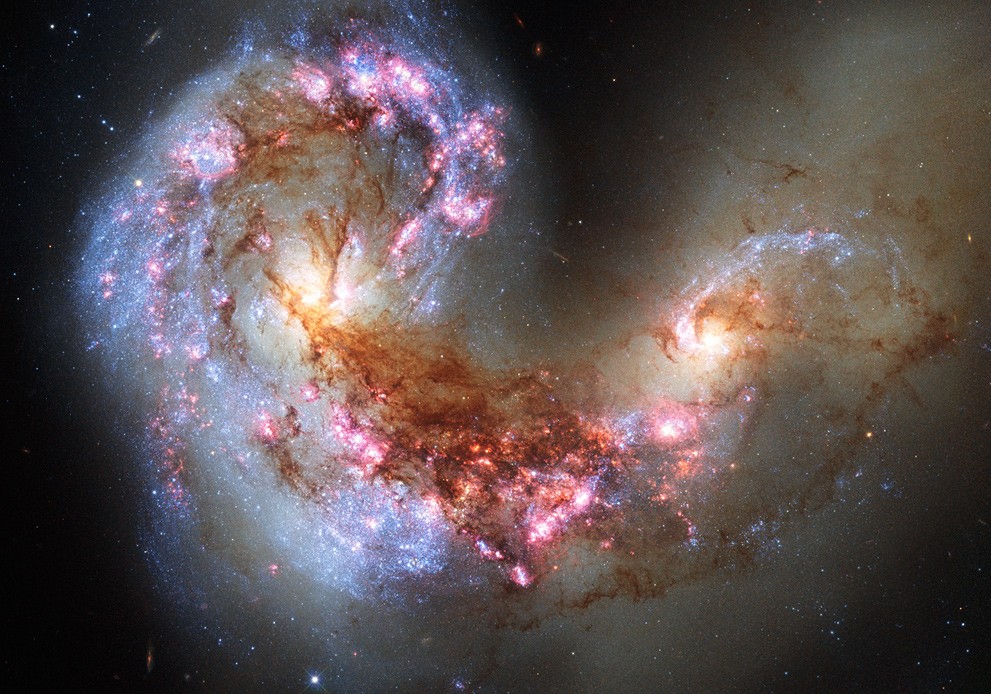
15. Antenna galaxies. Known as NGC 4038 and NGC 4039, these two galaxies are locked in a tight embrace. Once ordinary, quiet spiral galaxies like the Milky Way, the pair have spent the last few million years in such a violent collision that the stars torn out in the process have formed an arc between them. Bright pink and red clouds of gas surround bright flares from blue star-forming regions, some of which are partially obscured by dark streaks of dust. The frequency of star formation is so high that Antennae Galaxies are called places of constant star formation - in which all the gas inside the galaxies goes to create stars. (ESA/Hubble, NASA)

16. IRAS 23166+1655 is an unusual pre-planetary nebula, a celestial spiral around the star LL Pegasus. The spiral shape means that the nebula is formed in the usual way. The substance forming the spiral moves outward at a speed of 50,000 kilometers per hour; According to astronomers, its stages will separate from each other in 800 years. There is a hypothesis that the spiral will be reborn, because LL Pegasus is dual system, in which a star is losing matter, and neighboring star begin to revolve around each other. (ESA/NASA, R. Sahai)
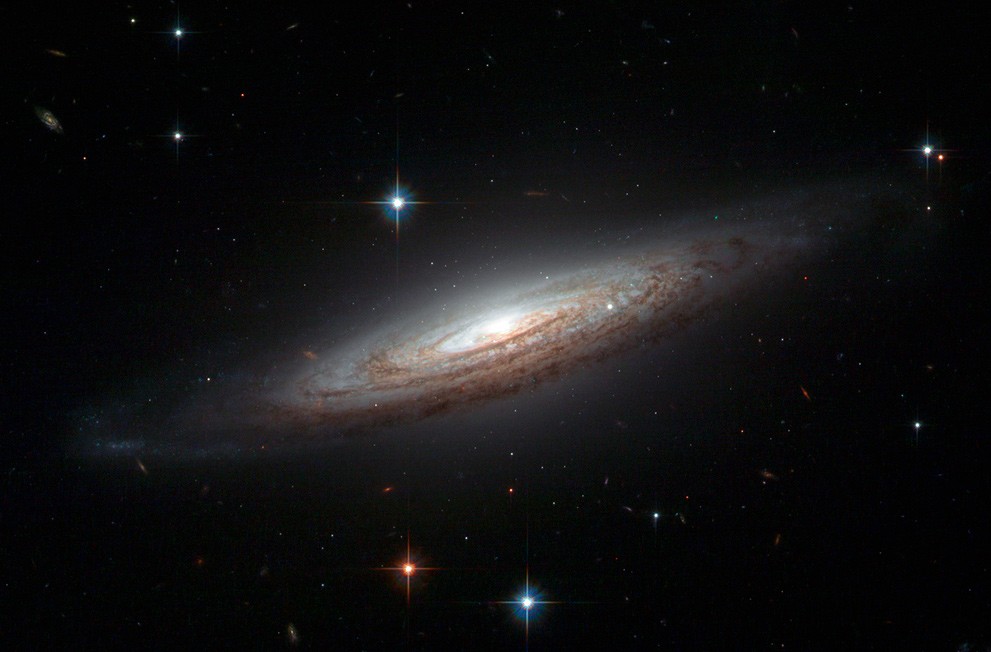
17. Spiral galaxy NGC 634 was discovered in the 19th century by French astronomer Edouard Jean-Marie Stéphane. It is approximately 120,000 light years in size and lies in the constellation Triangulum at a distance of 250 million light years. Other, more distant galaxies can be seen in the background. (ESA/Hubble, NASA)
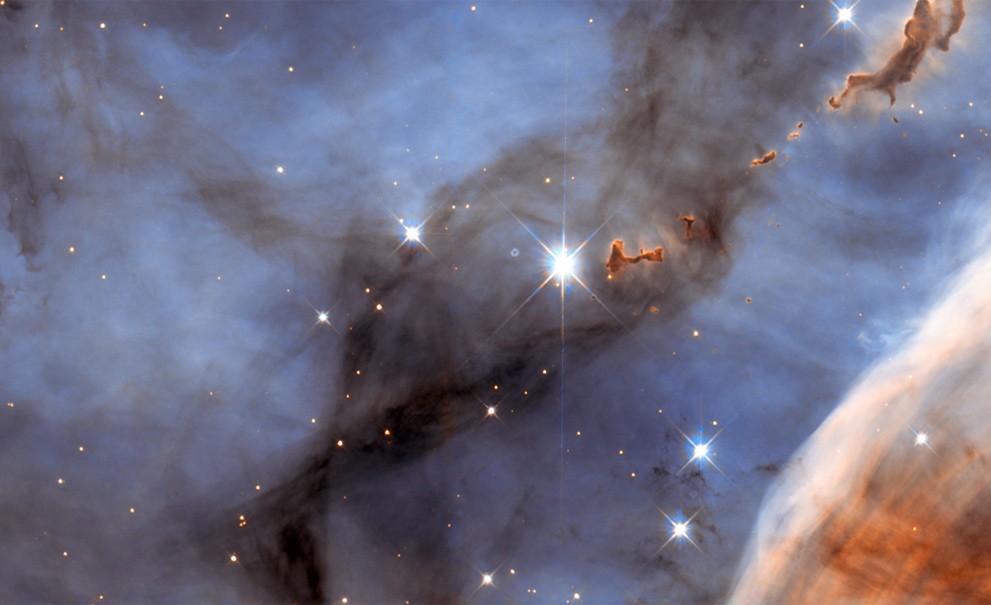
18. A small part of the Carina Nebula, a star-forming region located in the southern hemisphere constellation Carina at a distance of 7,500 light years from Earth. Young stars glow so brightly that the emitted radiation disrupts the surrounding gas, creating bizarre shapes. The dust clusters towards the top right corner of the photo, resembling a drop of ink in milk. It has been suggested that the forms of this dust are nothing more than cocoons for the formation of new stars. Brightest stars The ones closest to us in the photo are not parts of the Carina Nebula. (ESA/Hubble, NASA)
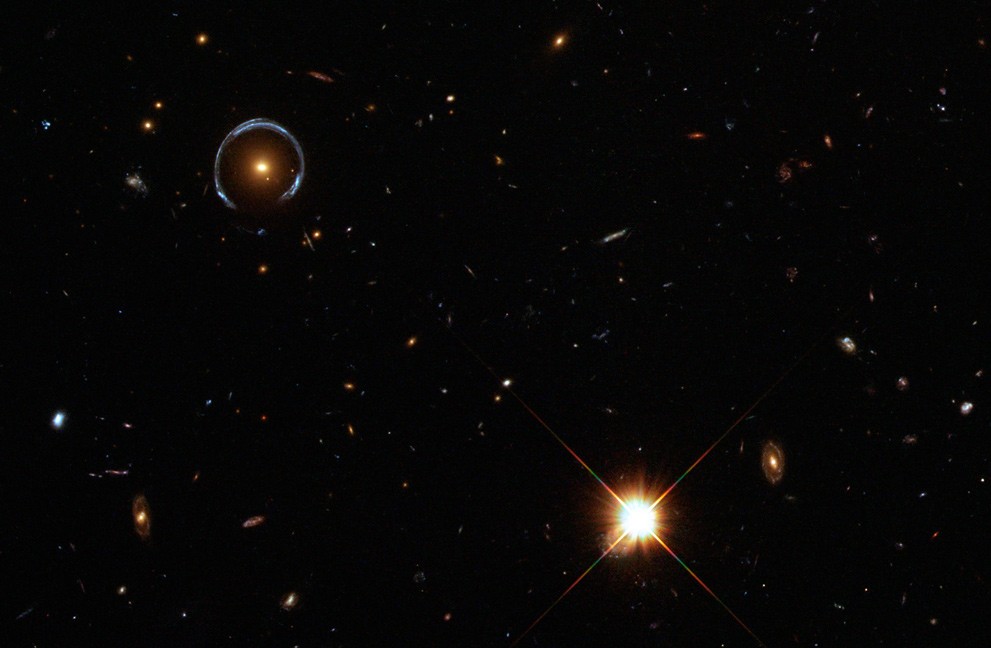
19. The bright Red Galaxy at the center has an unusually large mass, 10 times the mass of the Milky Way. The blue horseshoe shape is a distant galaxy that has been enlarged and distorted into an almost closed ring by the strong gravitational pull of the larger galaxy. This "Cosmic Horseshoe" is one of best examples Einstein rings - a "gravitational lens" effect with an ideal placement to bend light from distant galaxies into a ring shape around large nearby galaxies. The distant blue galaxy is approximately 10 billion light years away. (ESA/Hubble, NASA)
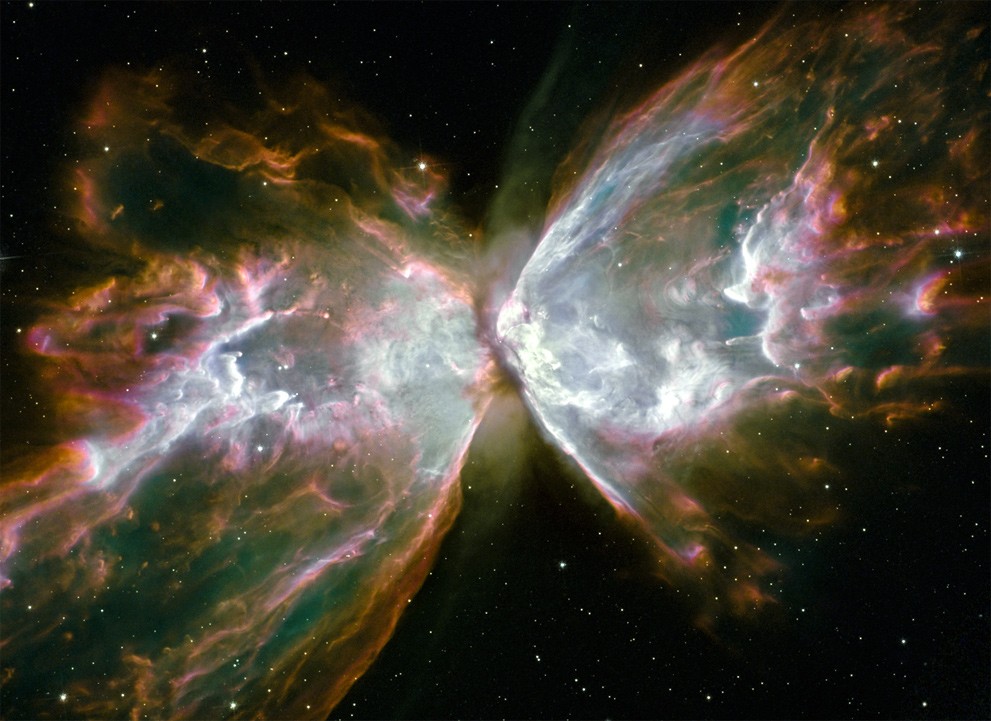
20. Planetary nebula NGC 6302, also known as the Butterfly Nebula, consists of seething pockets of gas heated to temperatures of 20,000 degrees Celsius. At the center is a dying star that was five times the mass of the Sun. She ejected her cloud of gases, and now emits ultraviolet radiation, from which the ejected substance glows. Located 3,800 light-years away, the central star is hidden under a ring of dust. (NASA, ESA and the Hubble SM4 ERO Team)
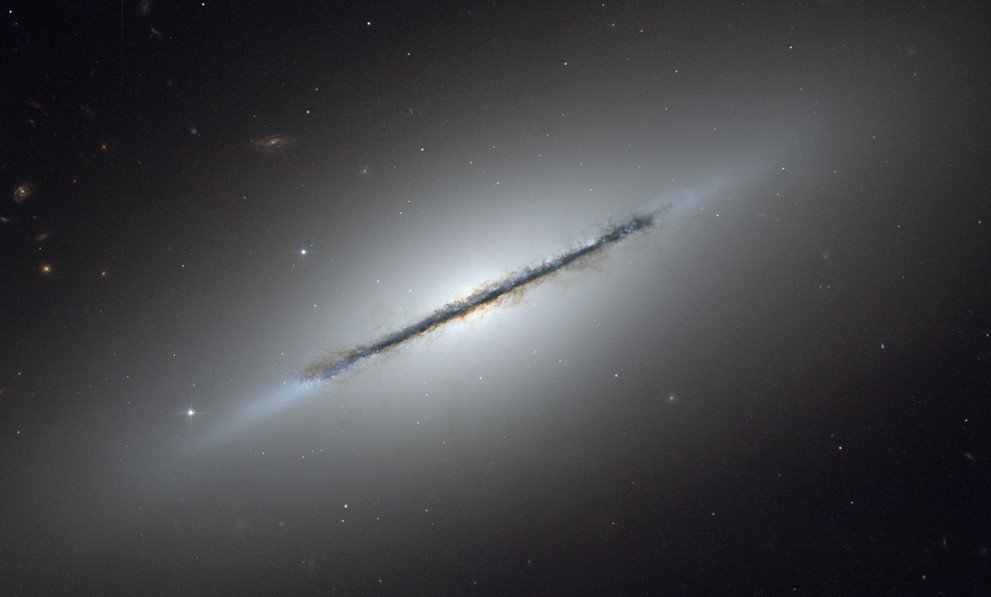
21. Disk galaxy NGC 5866 is located at a distance of about 50 million light years from Earth. The dust disk runs along the edge of the galaxy, revealing its structure behind it: a faint reddish bulge surrounding a bright core; blue star disk and transparent outer ring. Galaxies that are even millions of light years away are also visible through the ring. (NASA, ESA, and The Hubble Heritage Team)
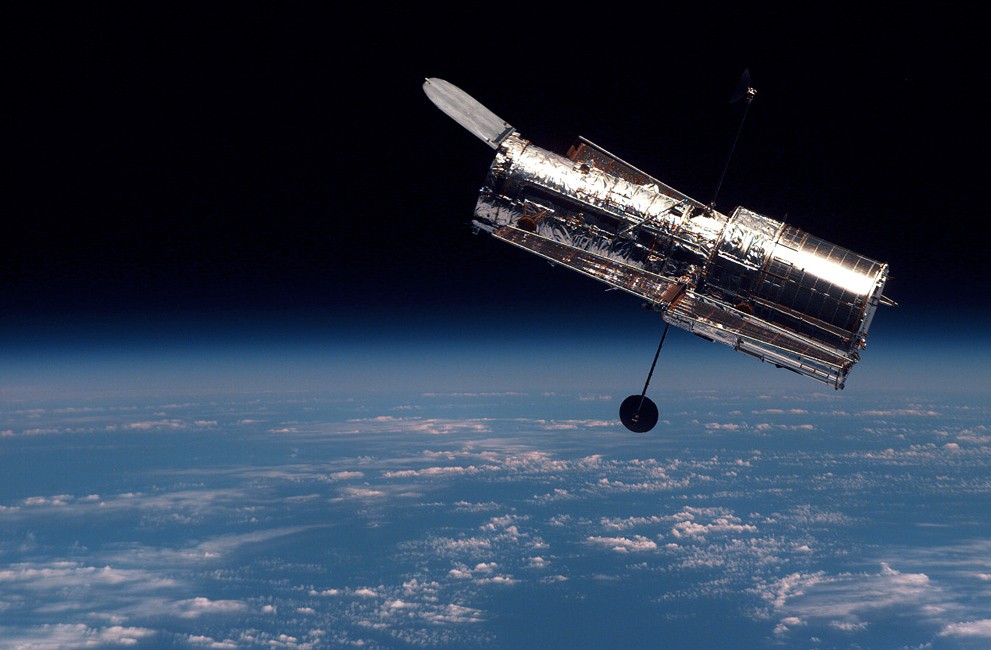
22. In February 1997, Hubble separated from the Discovery shuttle, completing its work in orbit. This telescope, measuring 13.2 m and weighing 11 tons, had spent about 24 years at that time. low earth orbit, taking thousands of priceless photographs. (NASA)
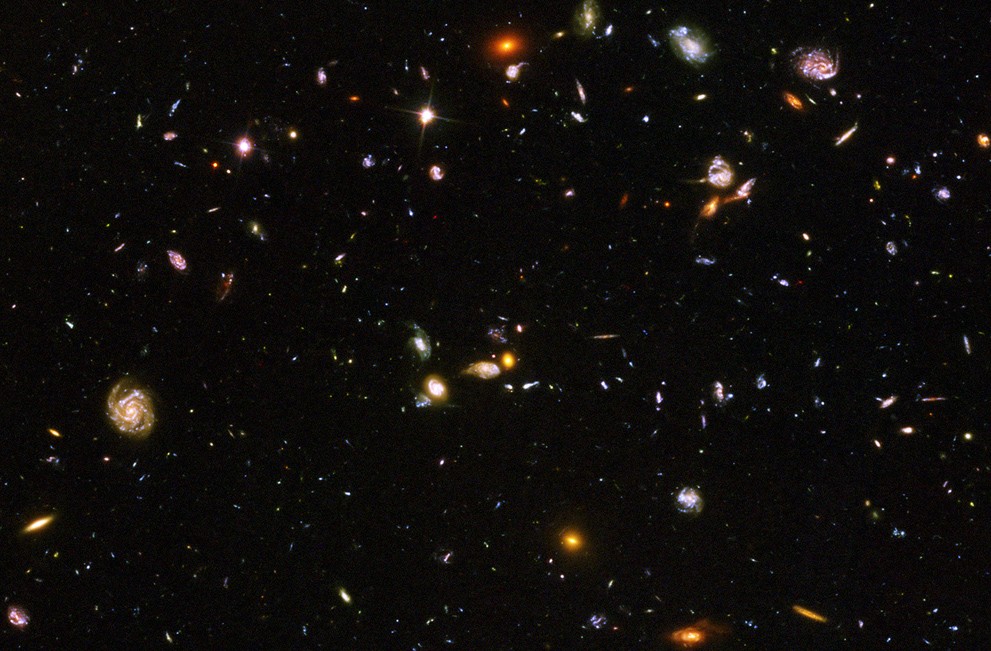
23. The Hubble Ultra Deep Field. Almost none of the objects in this photo are within our Milky Way galaxy. Almost every stroke, dot or spiral is an entire galaxy consisting of billions of stars. In late 2003, scientists pointed the Hubble telescope at a relatively dim patch of sky and simply opened the shutter for about one million seconds (about 11 days). The result is called the Ultra Deep Field - a snapshot of more than 10,000 previously unknown galaxies visible in our small sky. No other photograph before has demonstrated the unimaginable vastness of our universe. (NASA, ESA, S. Beckwith, STScI and the HUDF Team)
For 24 years now, the Hubble Space Telescope has been in orbit around the Earth, thanks to which scientists have made many discoveries and helped us better understand the Universe. However, Hubble telescope photographs are not only a help for scientific researchers, but also a pleasure for lovers of space and its secrets. We must admit that the Universe looks amazing in the telescope images. See the latest photos from the Hubble Telescope.
12 PHOTOS
1. Galaxy NGC 4526.
Behind the soulless name of NGC 4526 lies a small galaxy located in the so-called Virgo Cluster of Galaxies. This refers to the constellation Virgo. “The black dust belt, combined with the clear glow of the galaxy, creates a so-called halo effect in the dark void of space,” this is how the image was described on the website of the European Space Agency (ESA). The photo was taken on October 20, 2014. (Photo: ESA).
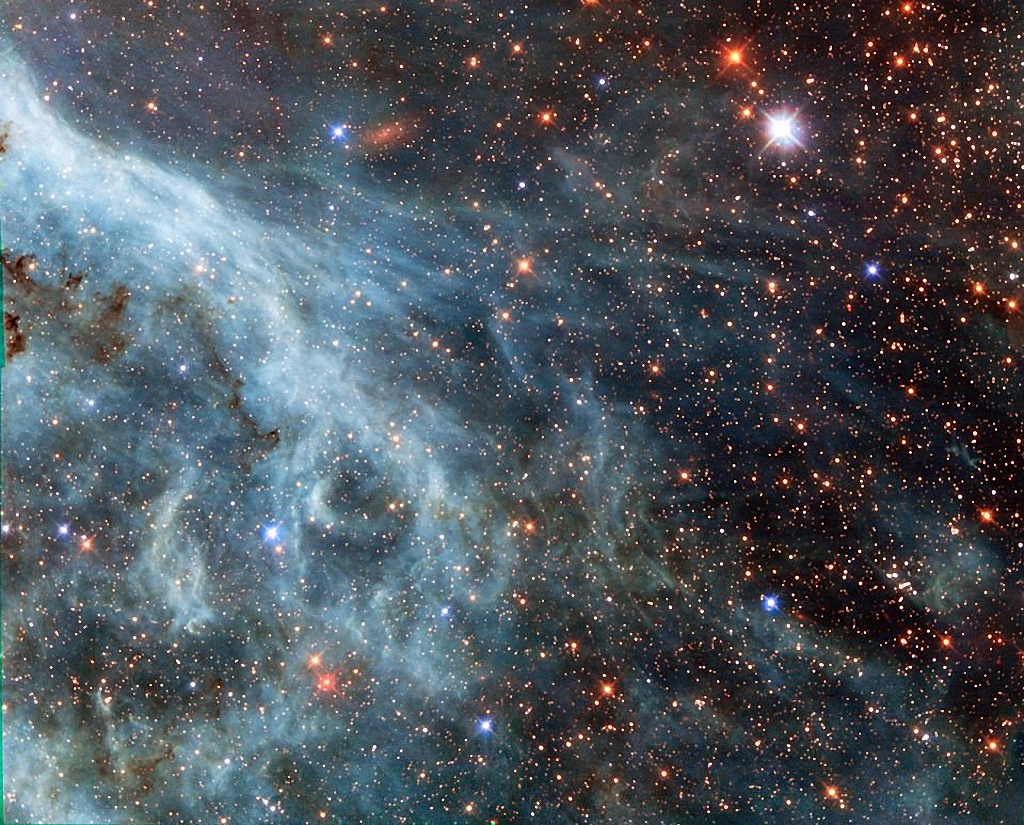 2. Large Magellanic Cloud.
2. Large Magellanic Cloud. The image shows only part of the Large Magellanic Cloud, one of the closest galaxies to the Milky Way. It is visible from Earth, but unfortunately does not look as impressive as in photographs from the Hubble telescope, which “showed people amazing swirling clouds of gas and shining stars,” ESA writes. The photo was taken on October 13. (Photo: ESA).
 3. Galaxy NGC 4206.
3. Galaxy NGC 4206. Another galaxy from the constellation Virgo. Do you see many small blue dots around the central part of the galaxy in the image? These are stars being born. Amazing, right? The photo was taken on October 6. (Photo: ESA).
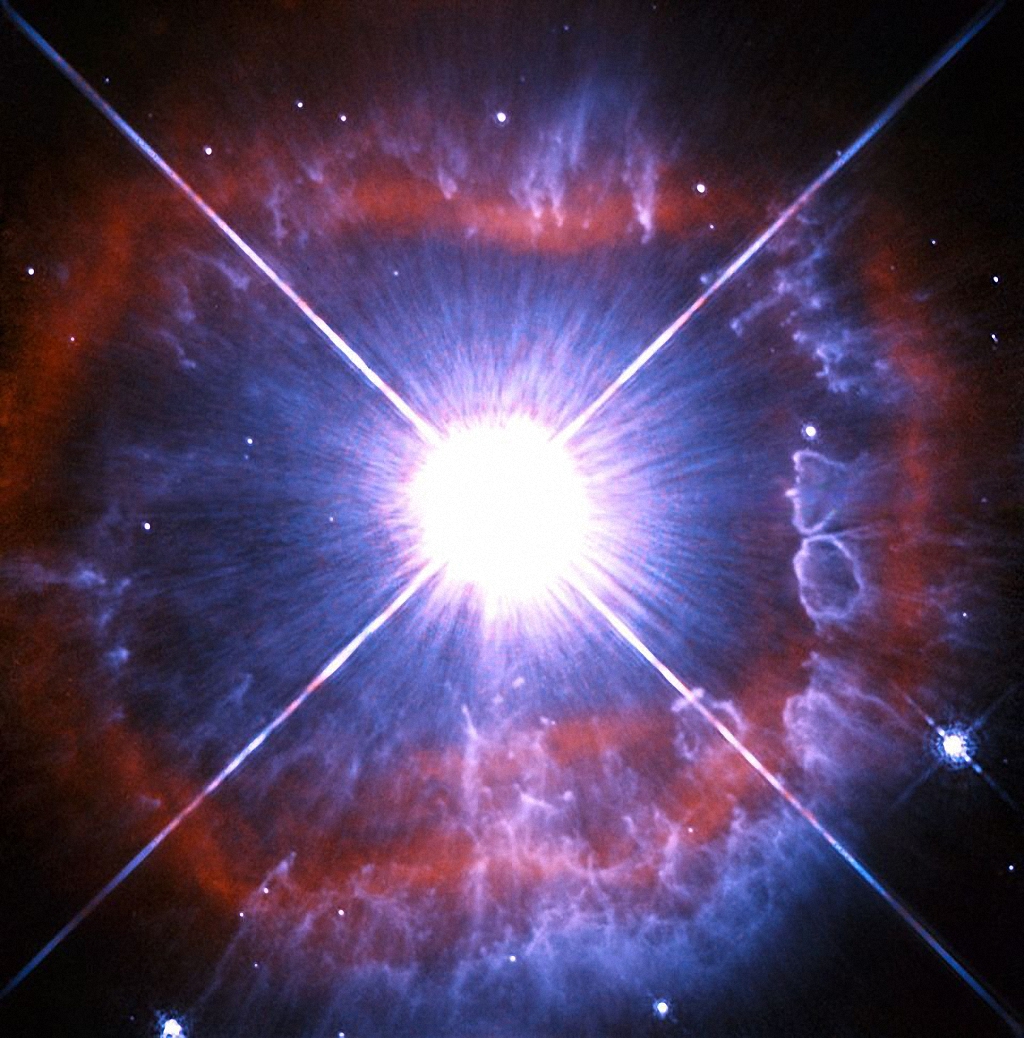 4. Star AG Carinae.
4. Star AG Carinae. This star in the constellation Carina is at the final stage of evolution of absolute brightness. It is millions of times brighter than the Sun. The Hubble Space Telescope photographed it on September 29. (Photo: ESA).
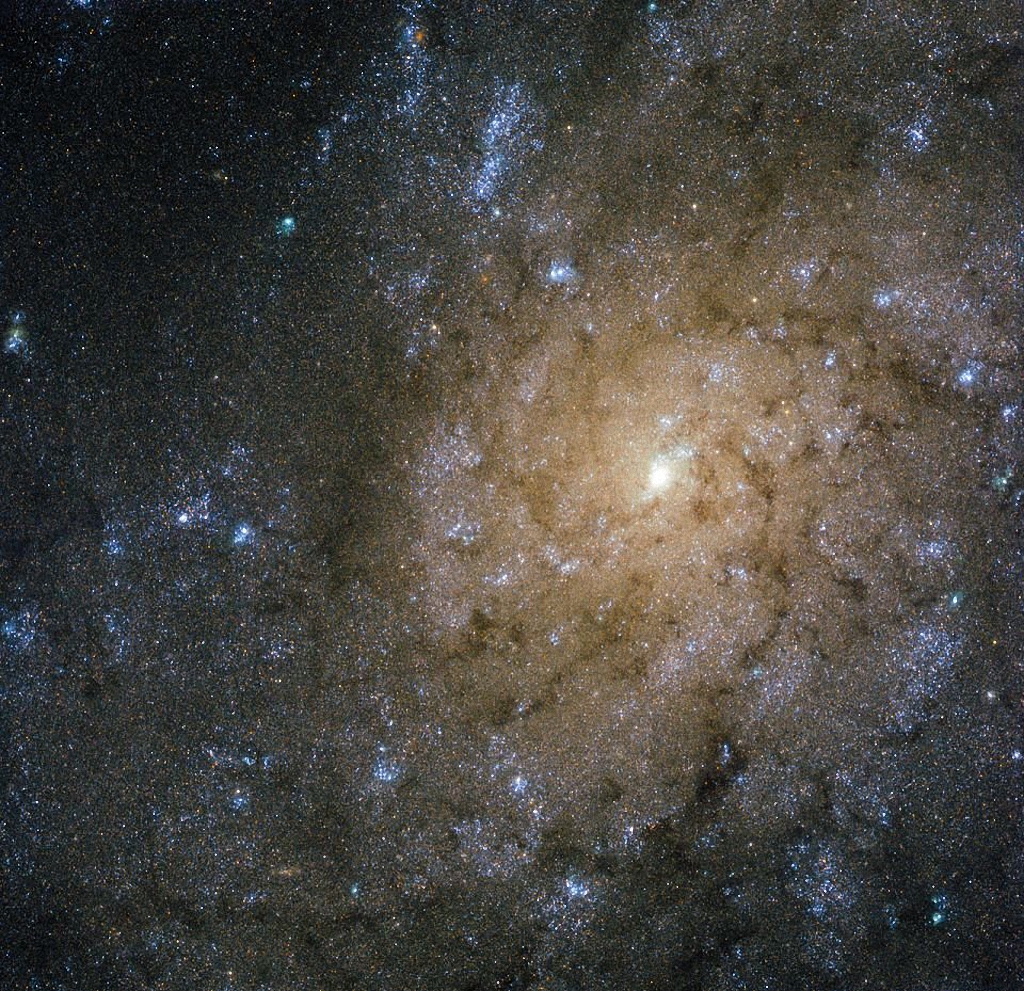 5. Galaxy NGC 7793.
5. Galaxy NGC 7793. NGC 7793 is a spiral galaxy in the constellation Sculptor, which is located 13 million light-years from Earth. The photo was taken on September 22. (Photo: ESA).
 6. Galaxy NGC 6872.
6. Galaxy NGC 6872. NGC 6872 is located in the constellation Pavo, which is located at the edge of the Milky Way. Its unusual shape is caused by the influence of a smaller galaxy, IC 4970, which is visible directly above it in the image. These galaxies are located at a distance of 300 million light years from Earth. Hubble photographed them on September 15. (Photo: ESA).
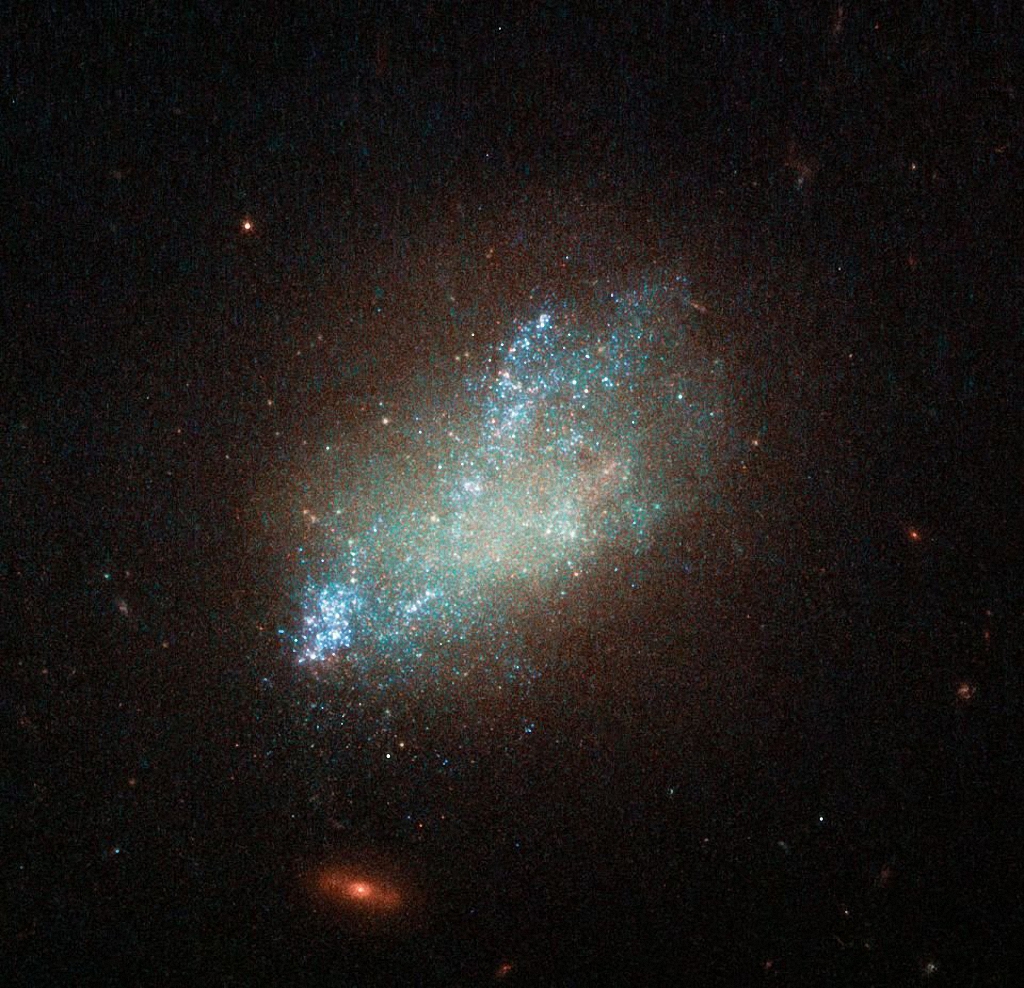 7. Galactic anomaly IC 55.
7. Galactic anomaly IC 55. This image taken on September 8 shows a very unusual galaxy, IC 55, with anomalies: bright blue starbursts and an irregular shape. It resembles a delicate cloud, but is actually made of gas and dust from which new stars are born. (Photo: ESA).
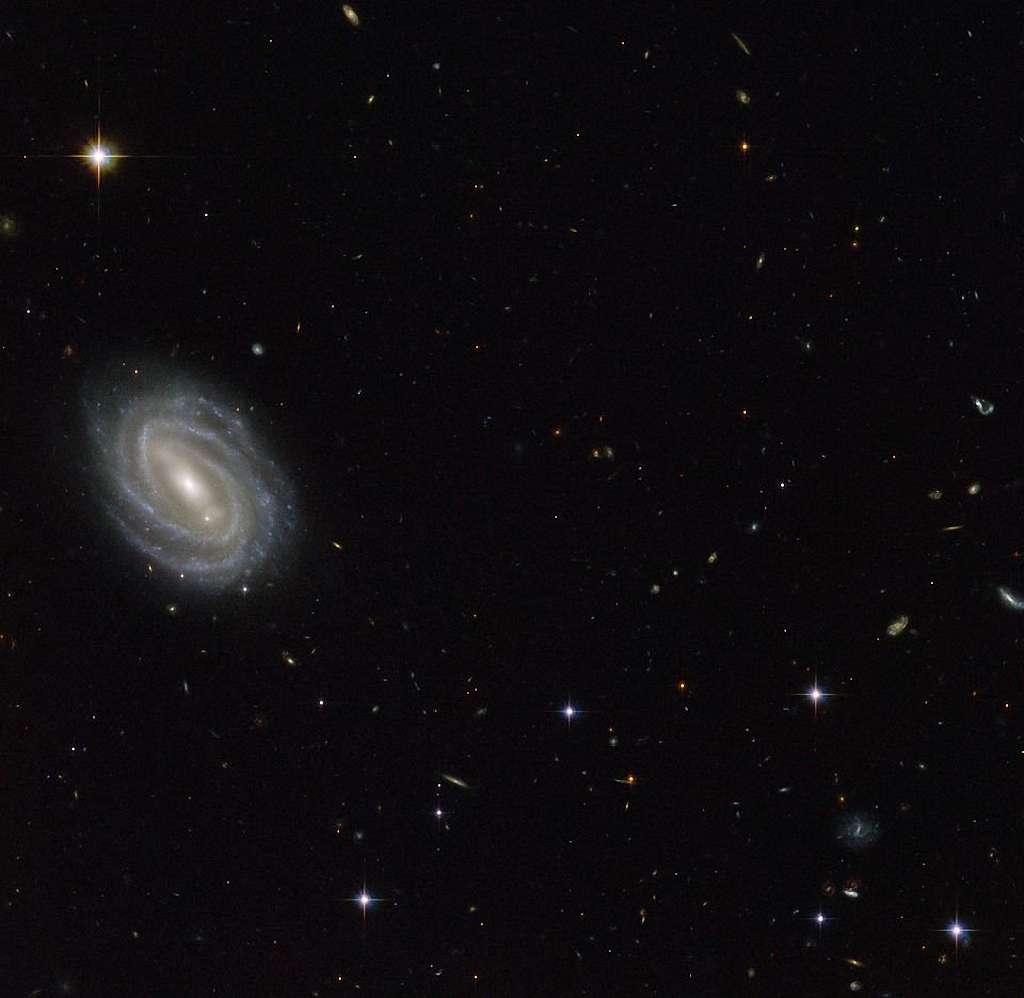 8. Galaxy PGC 54493.
8. Galaxy PGC 54493. This beautiful spiral galaxy is located in the constellation Serpens. It was studied by astronomers as an example of weak gravitational lensing - physical phenomenon associated with the deflection of light rays in the gravitational field. The photo was taken on September 1st. (Photo: ESA).
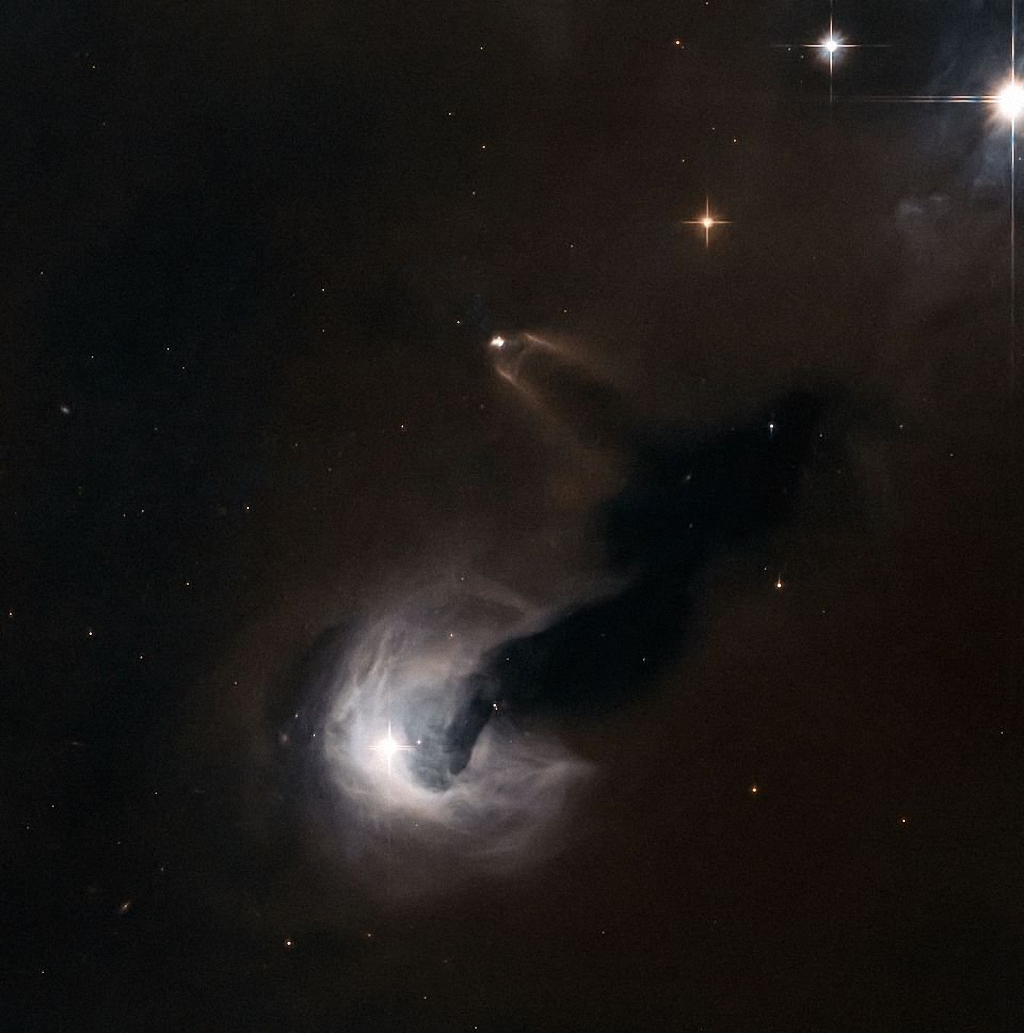 9. Object SSTC2D J033038.2 + 303212.
9. Object SSTC2D J033038.2 + 303212. Giving such a name to an object is certainly something. Behind the incomprehensible and long numerical name lies the so-called “young stellar object” or, in simple terms, a nascent star. Amazingly, this nascent star is surrounded by a glowing spiral cloud containing the material from which it will be built. The photo was taken on August 25. (Photo: ESA).
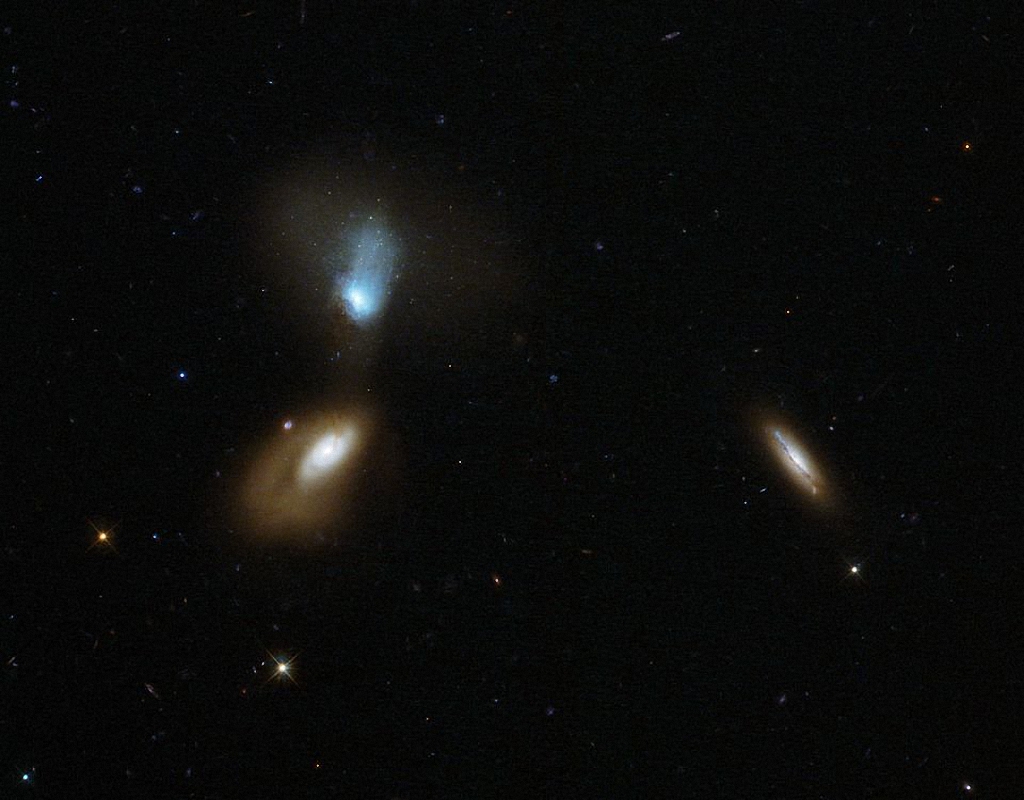 11. Globular star cluster IC 4499.
11. Globular star cluster IC 4499. Globular clusters are made up of old, gravitationally bound stars that move around their host galaxy. Such clusters usually consist of a large number of stars: from one hundred thousand to a million. The photo was taken on August 4. (Photo: ESA).
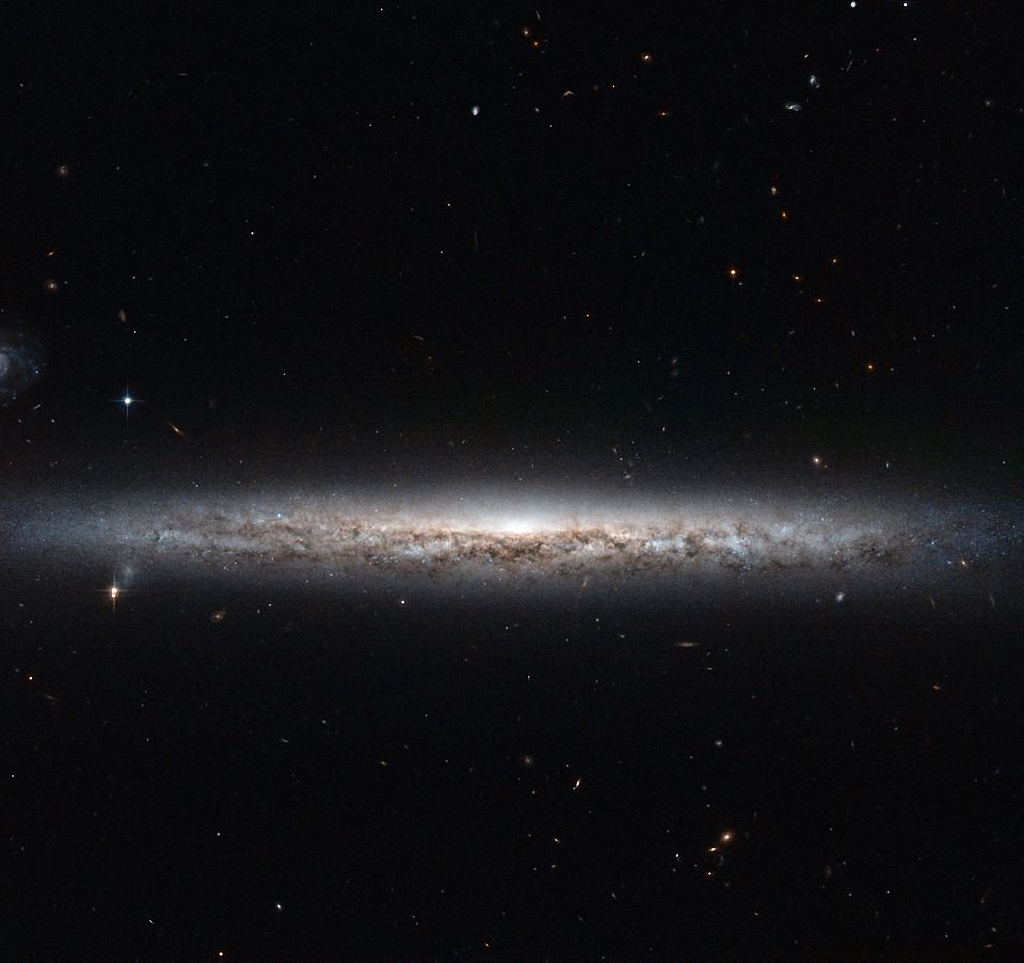 12. Galaxy NGC 3501.
12. Galaxy NGC 3501. This thin, glowing, accelerating galaxy is racing toward another galaxy, NGC 3507. Photo taken July 21. (Photo: ESA).
You can see amazing photographs taken by the Hubble Space Telescope at Spacetelescope.org.
